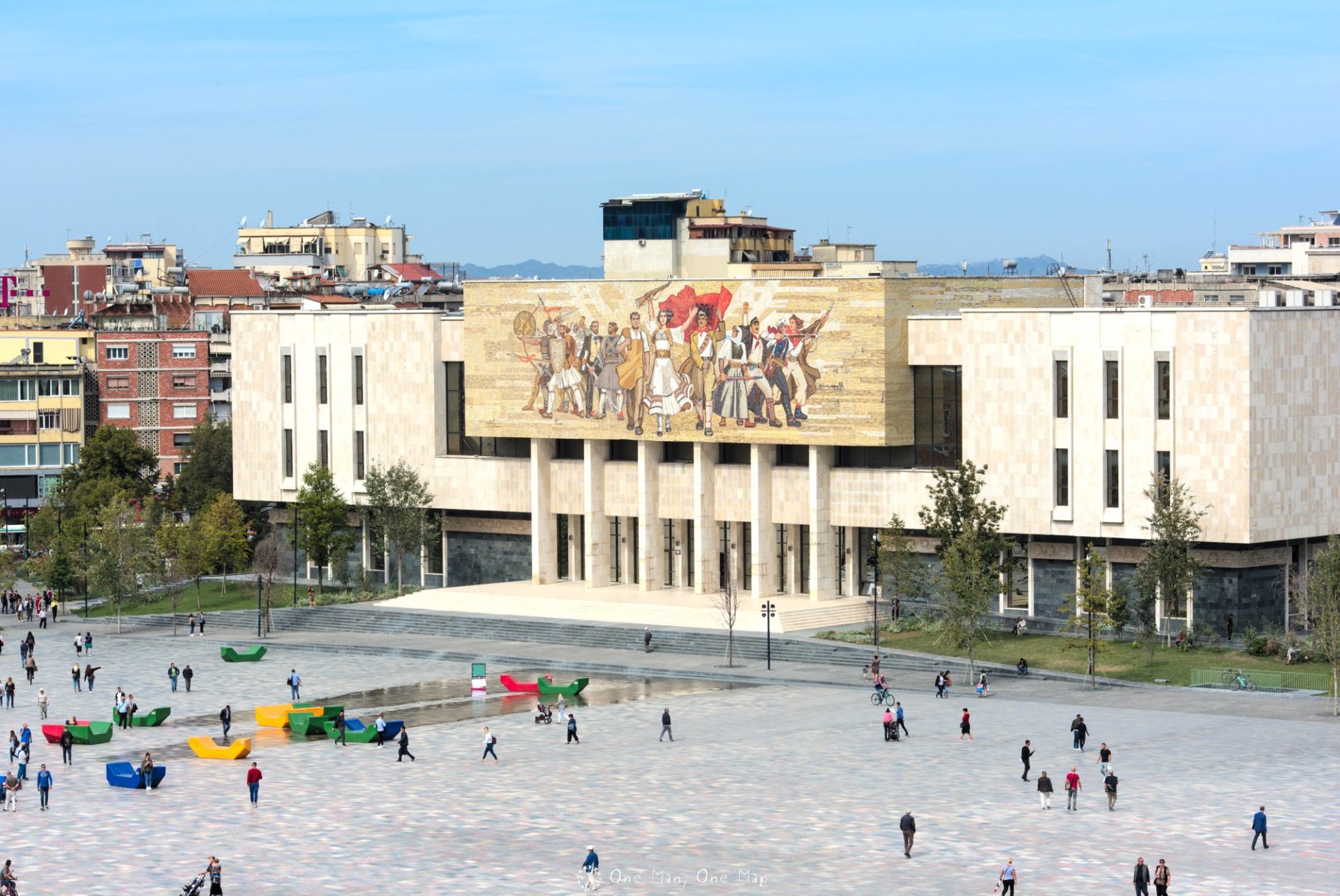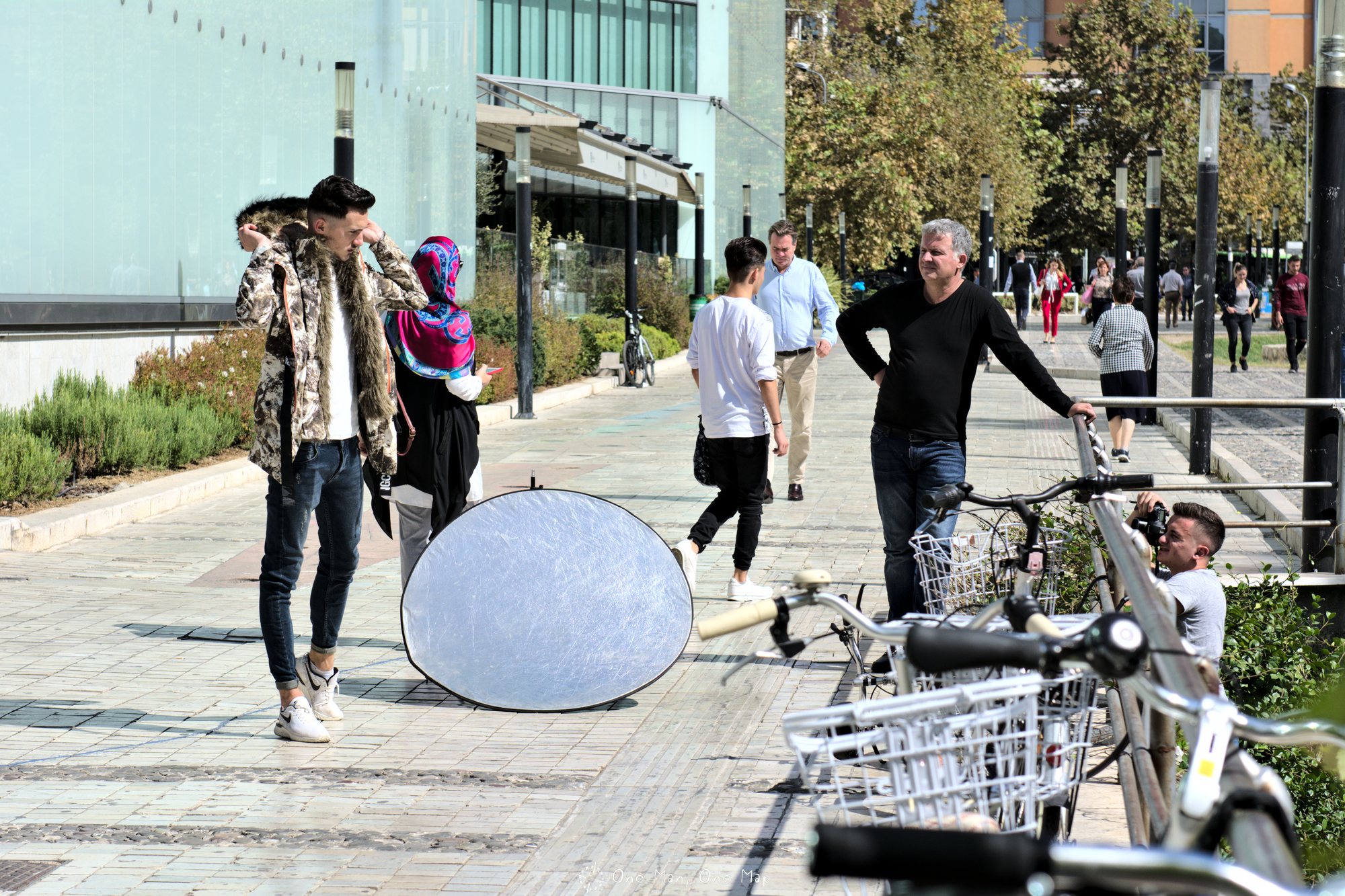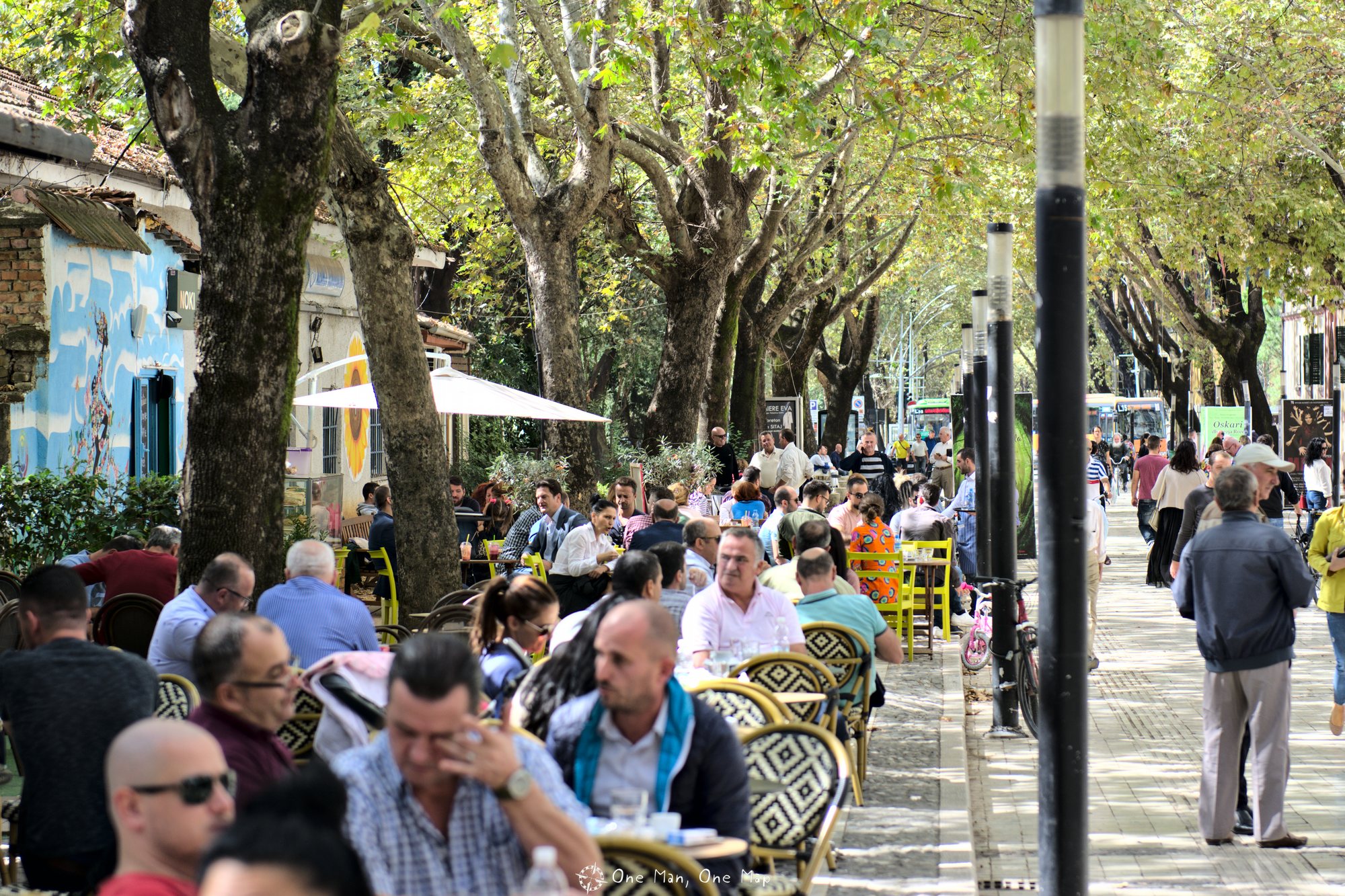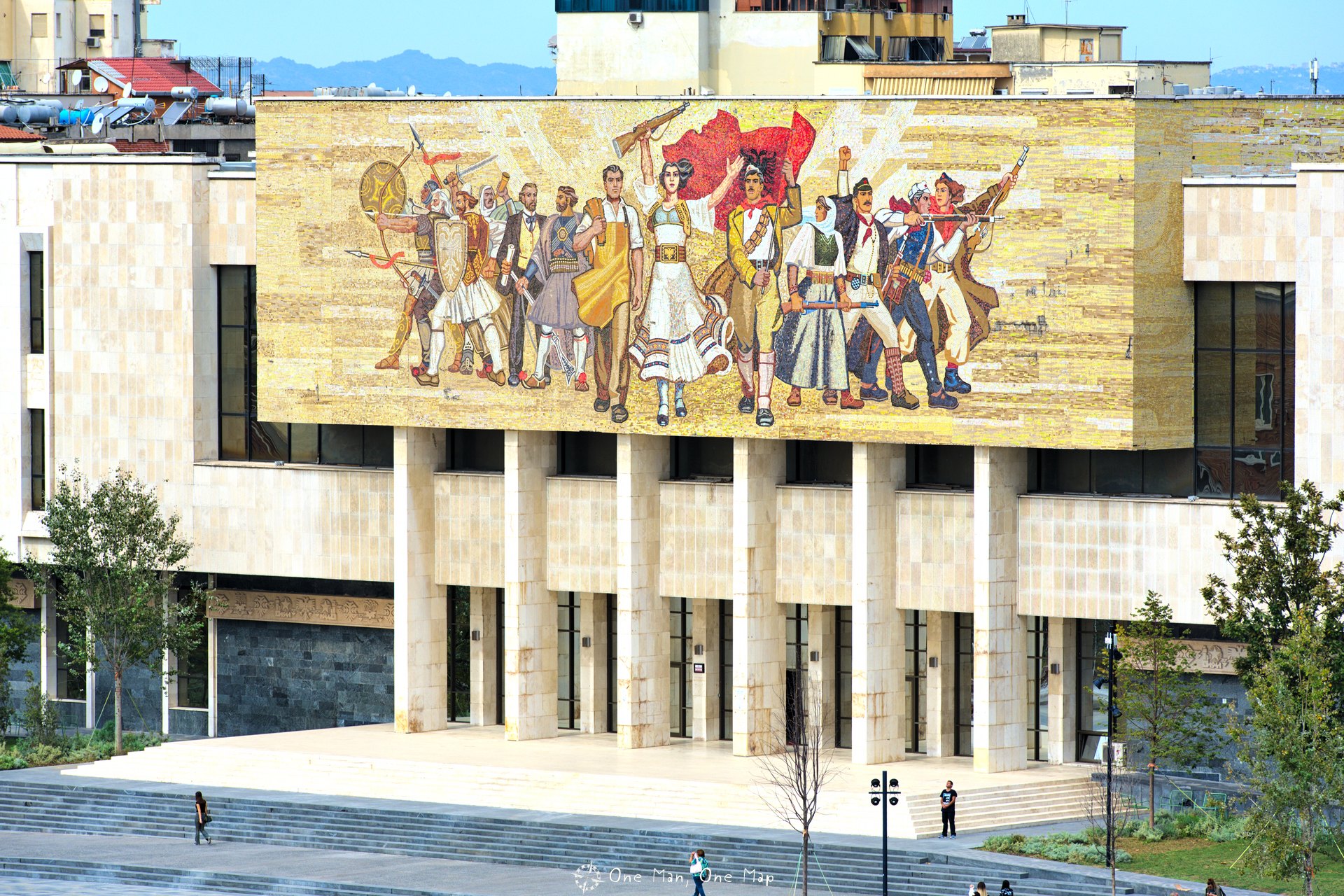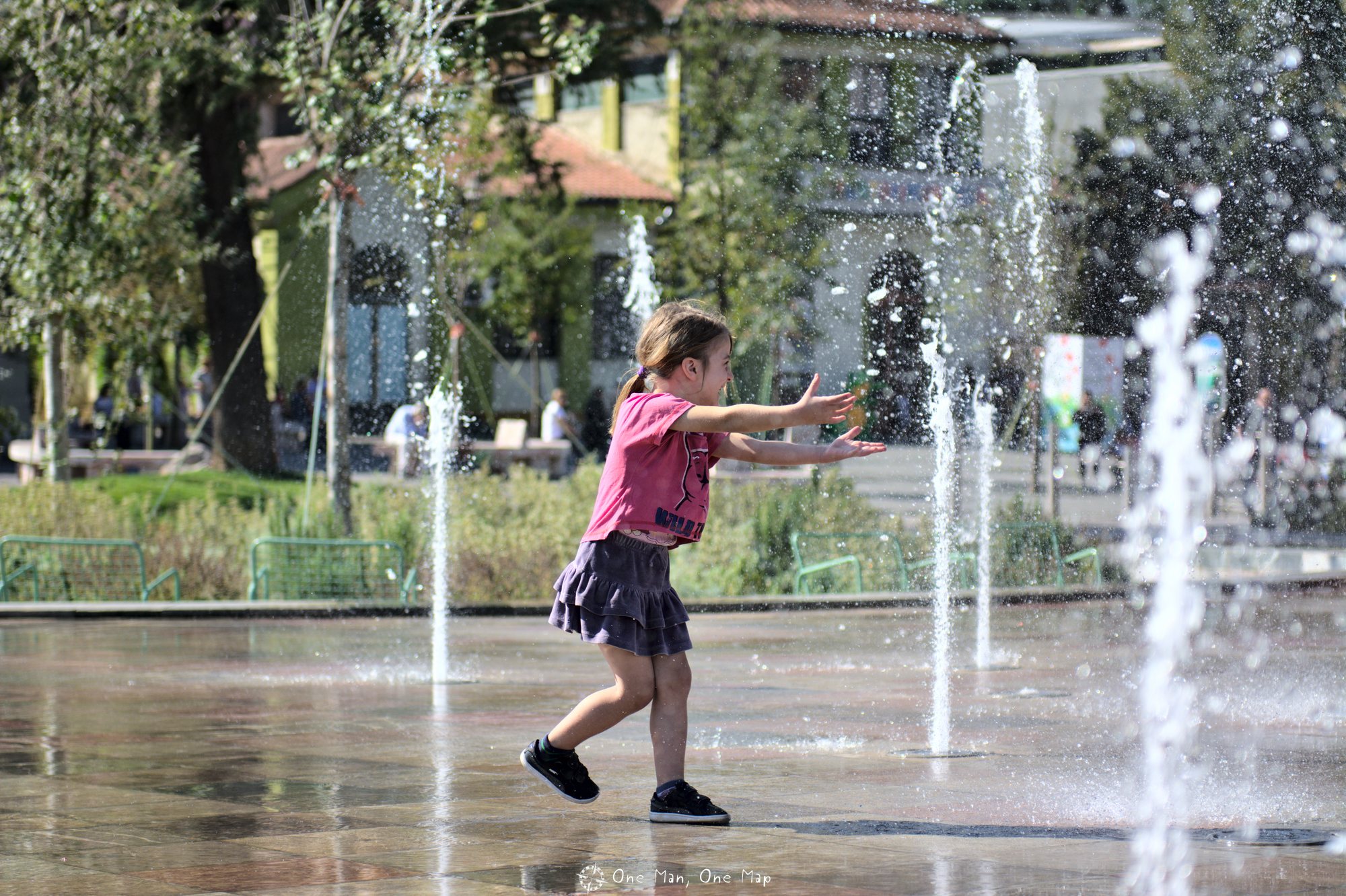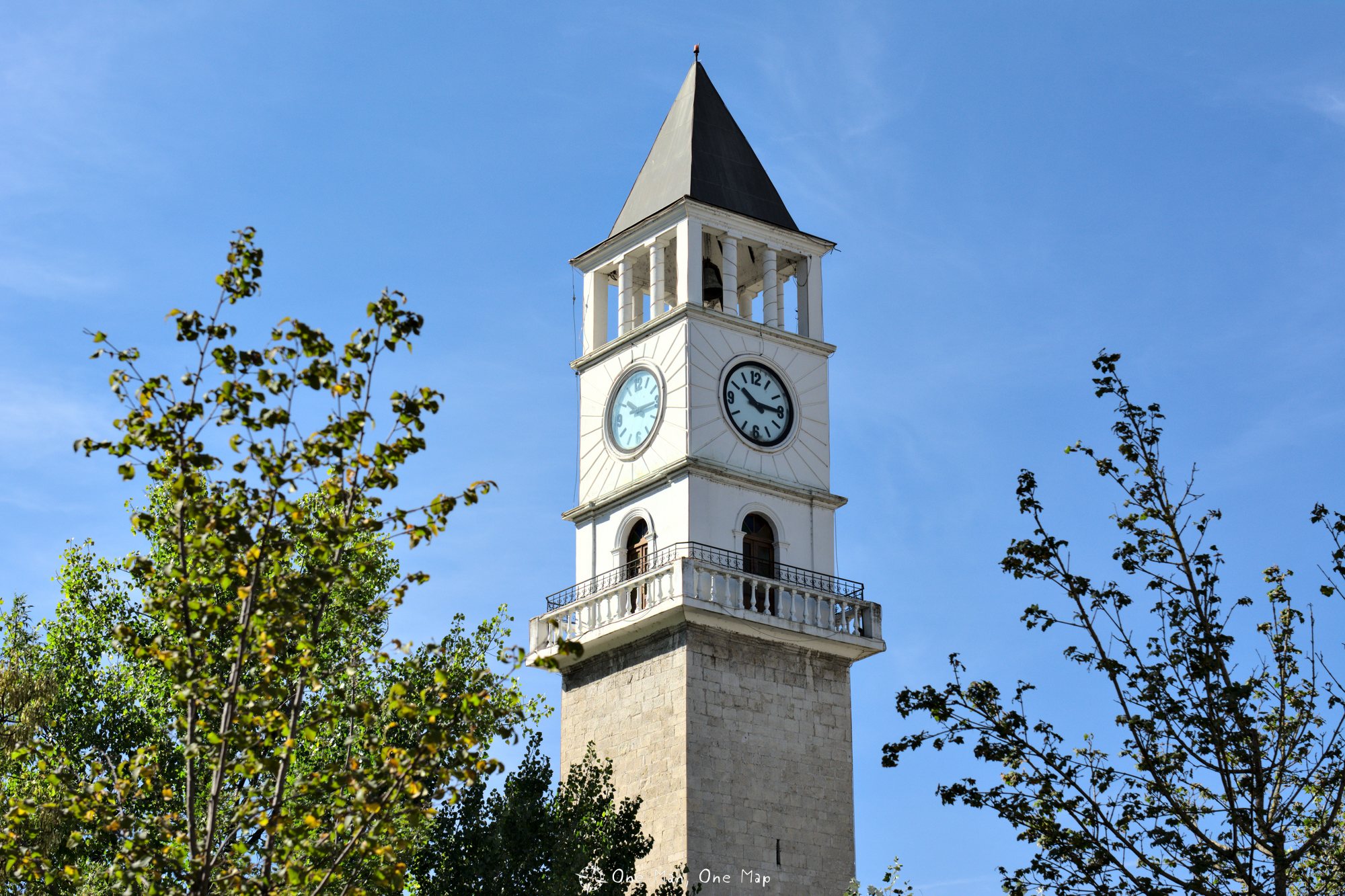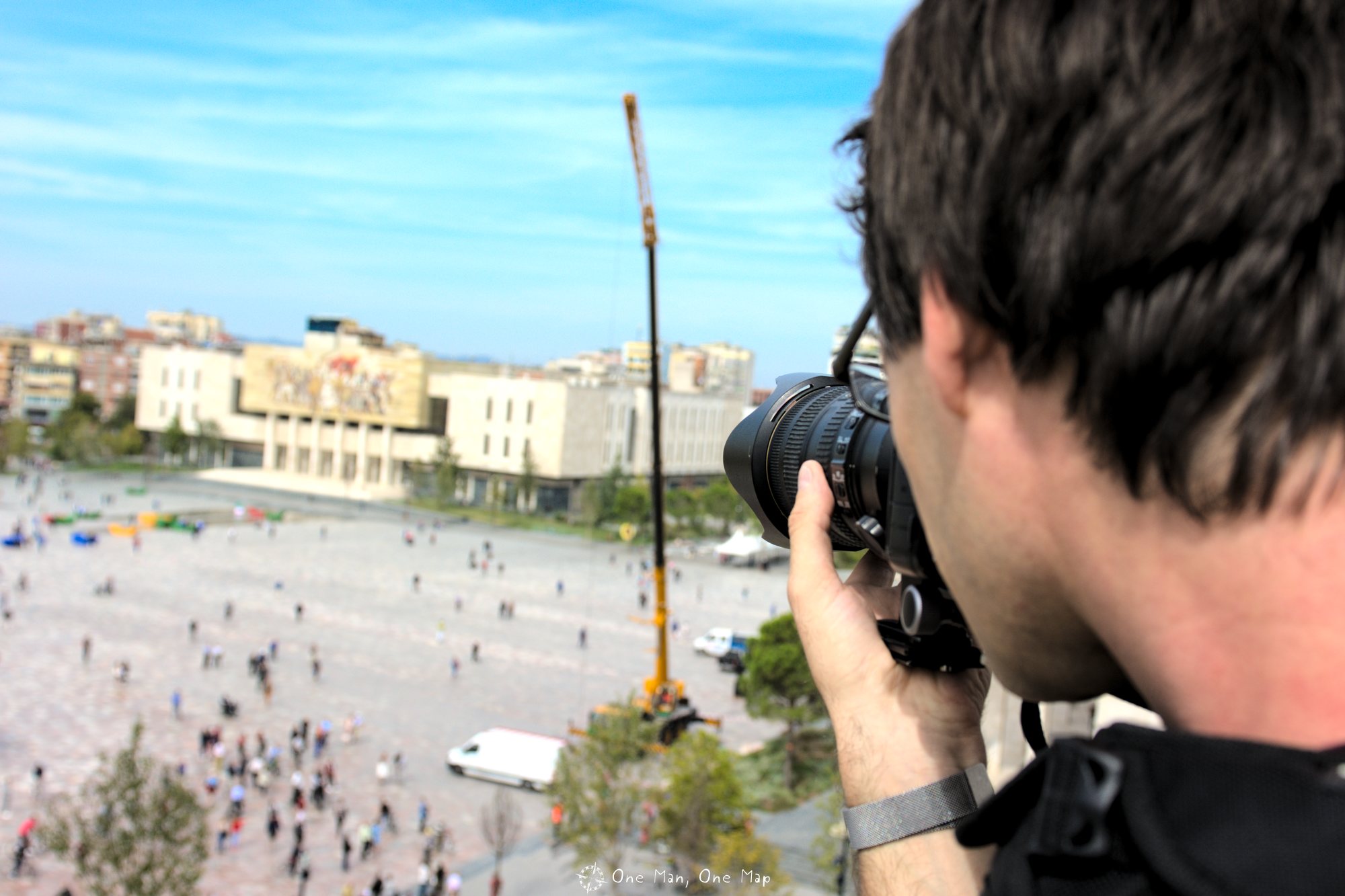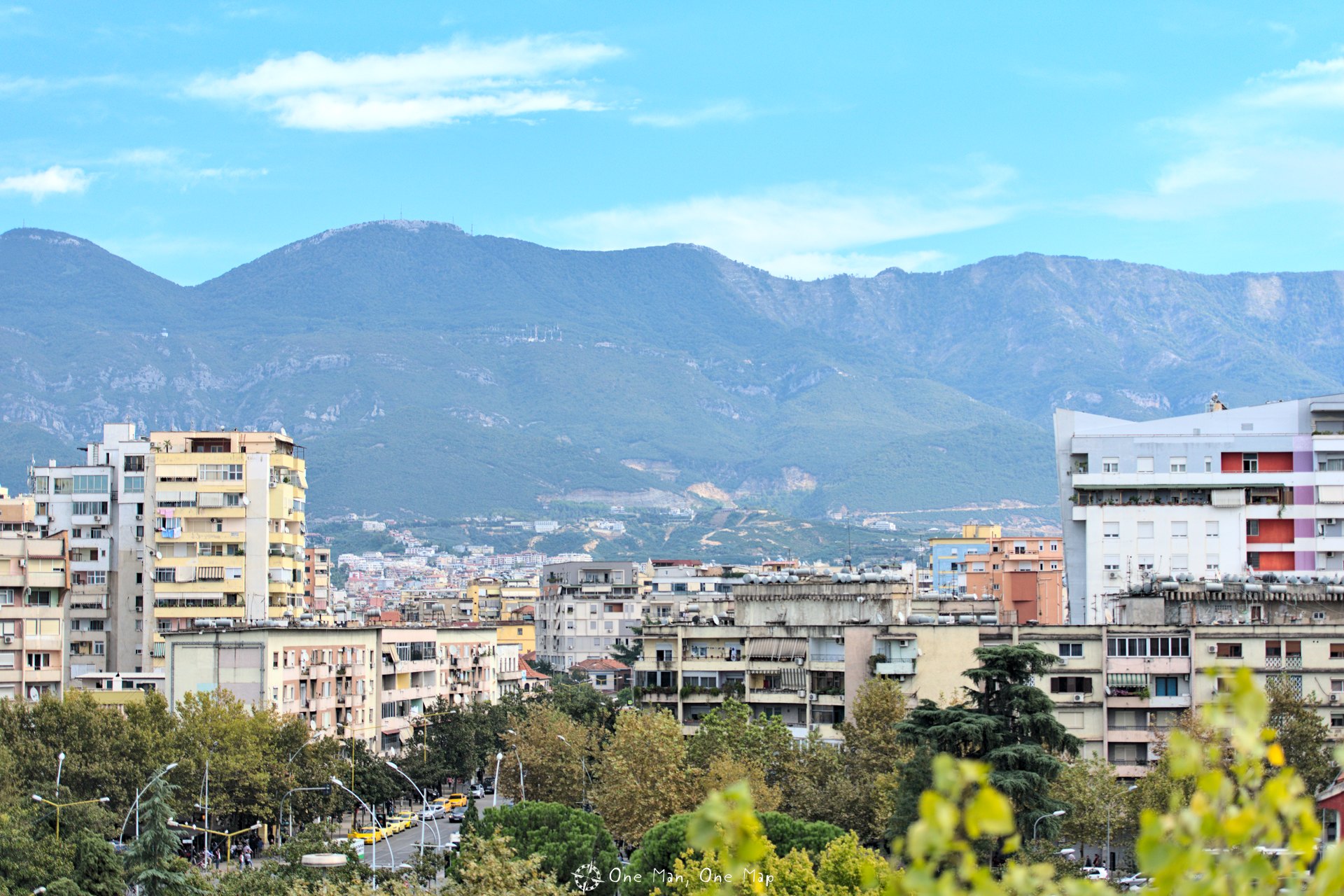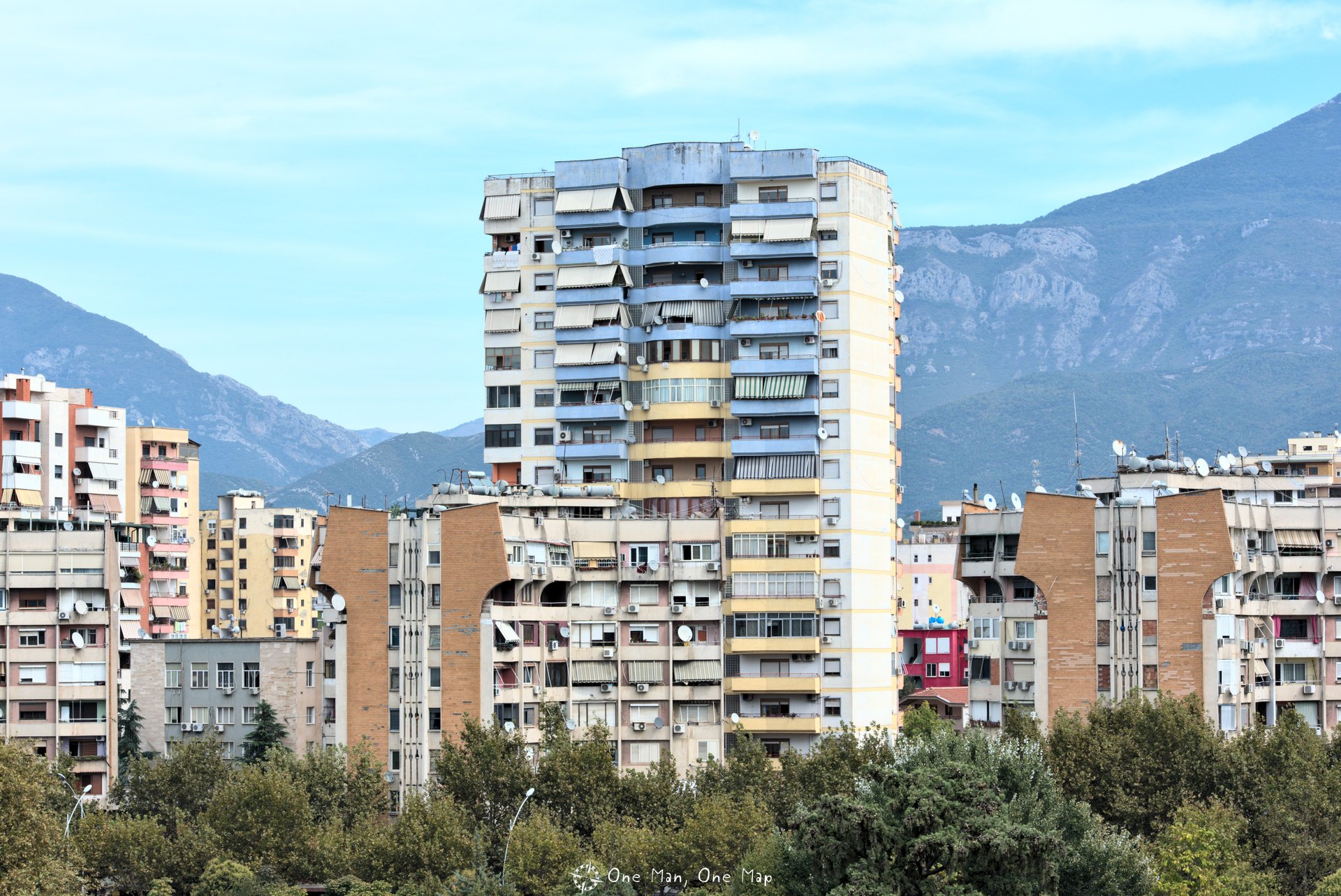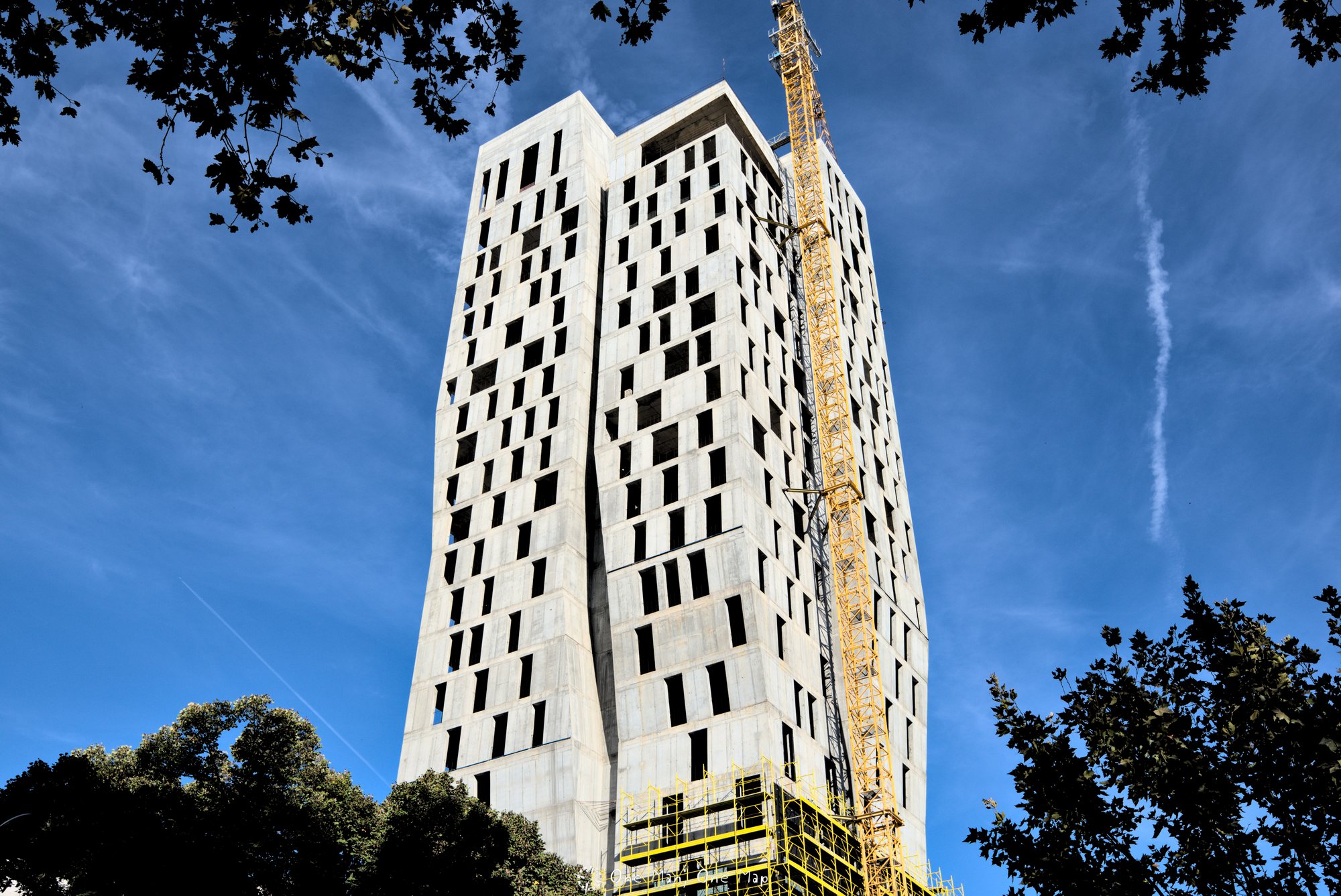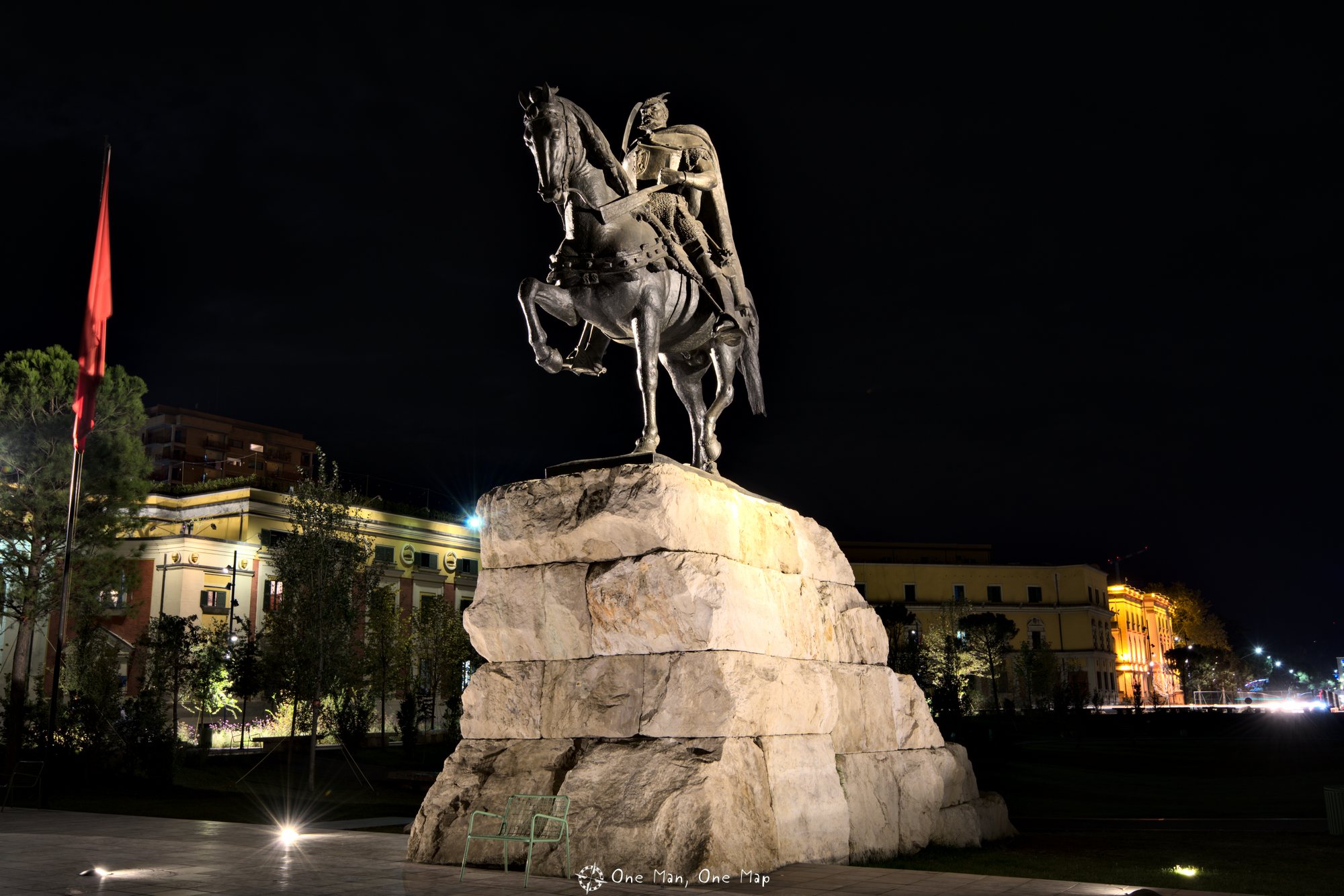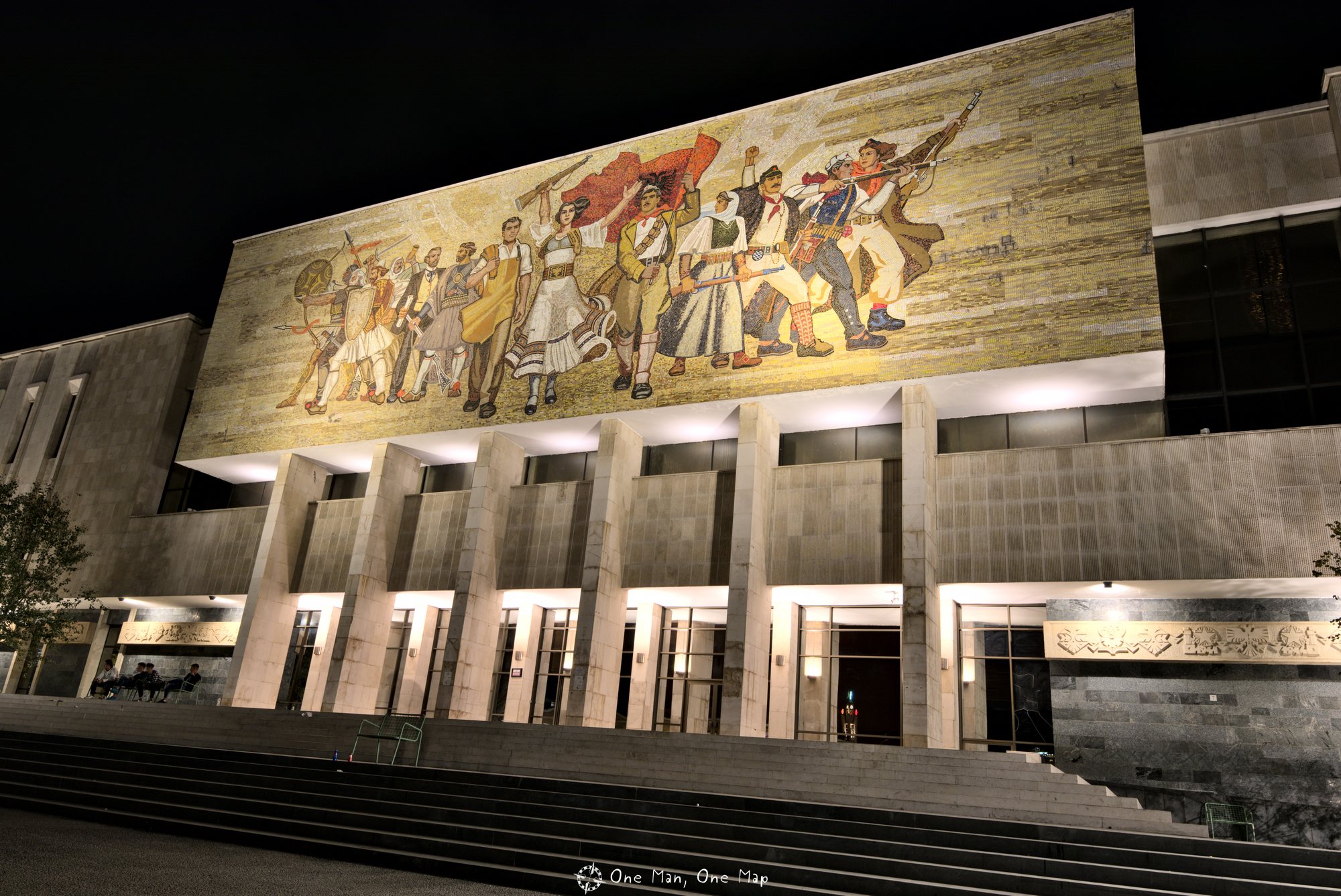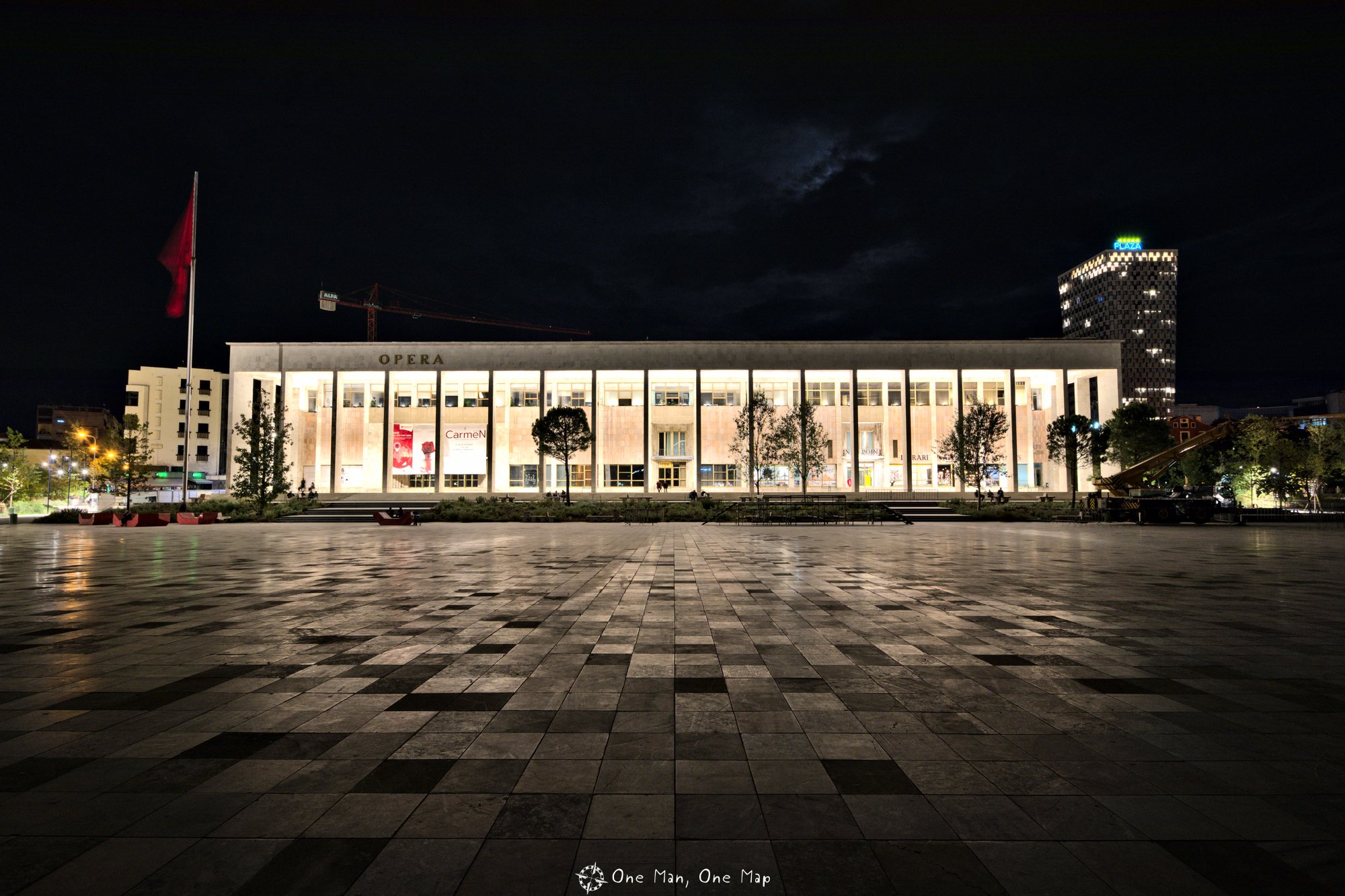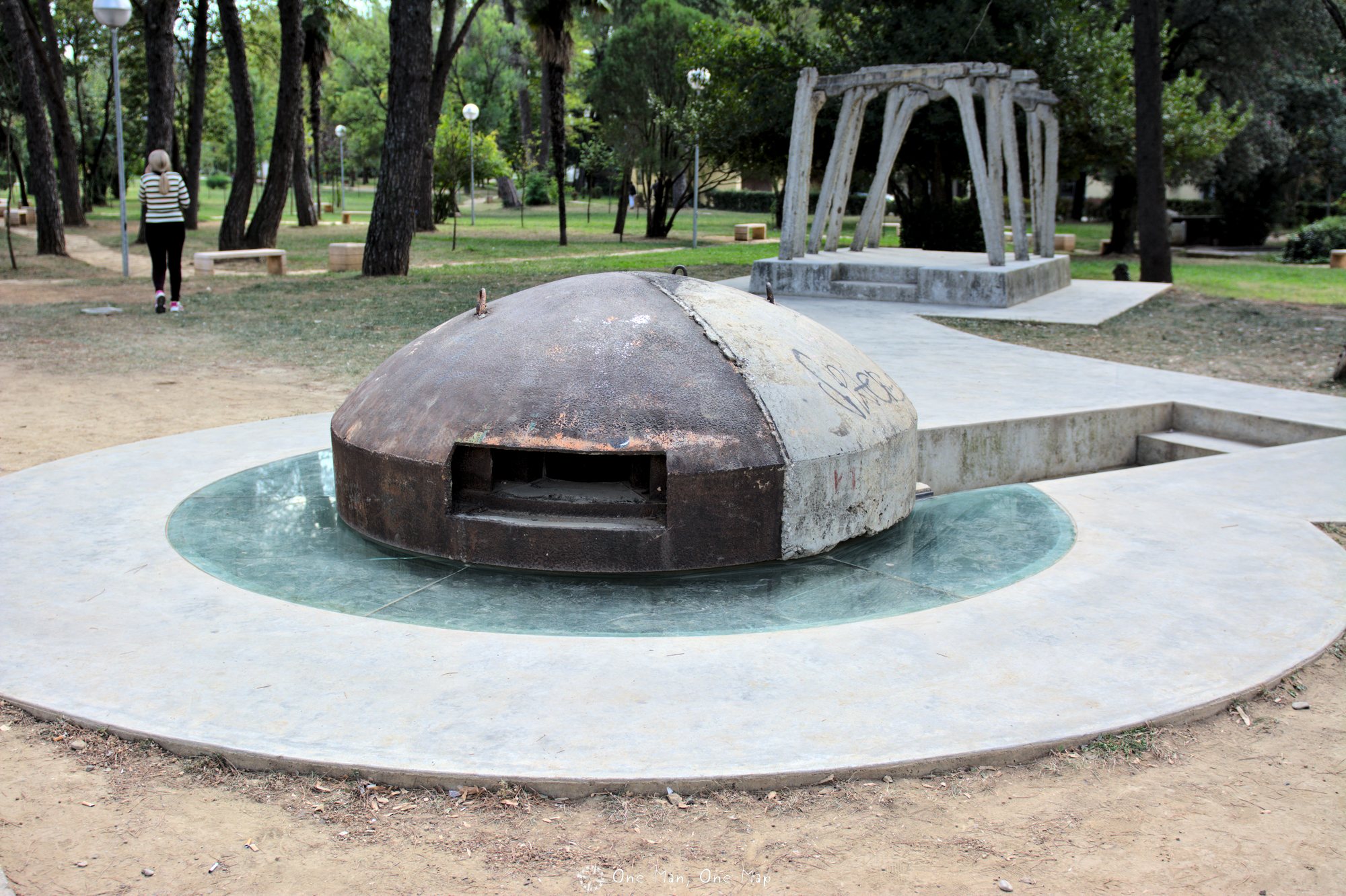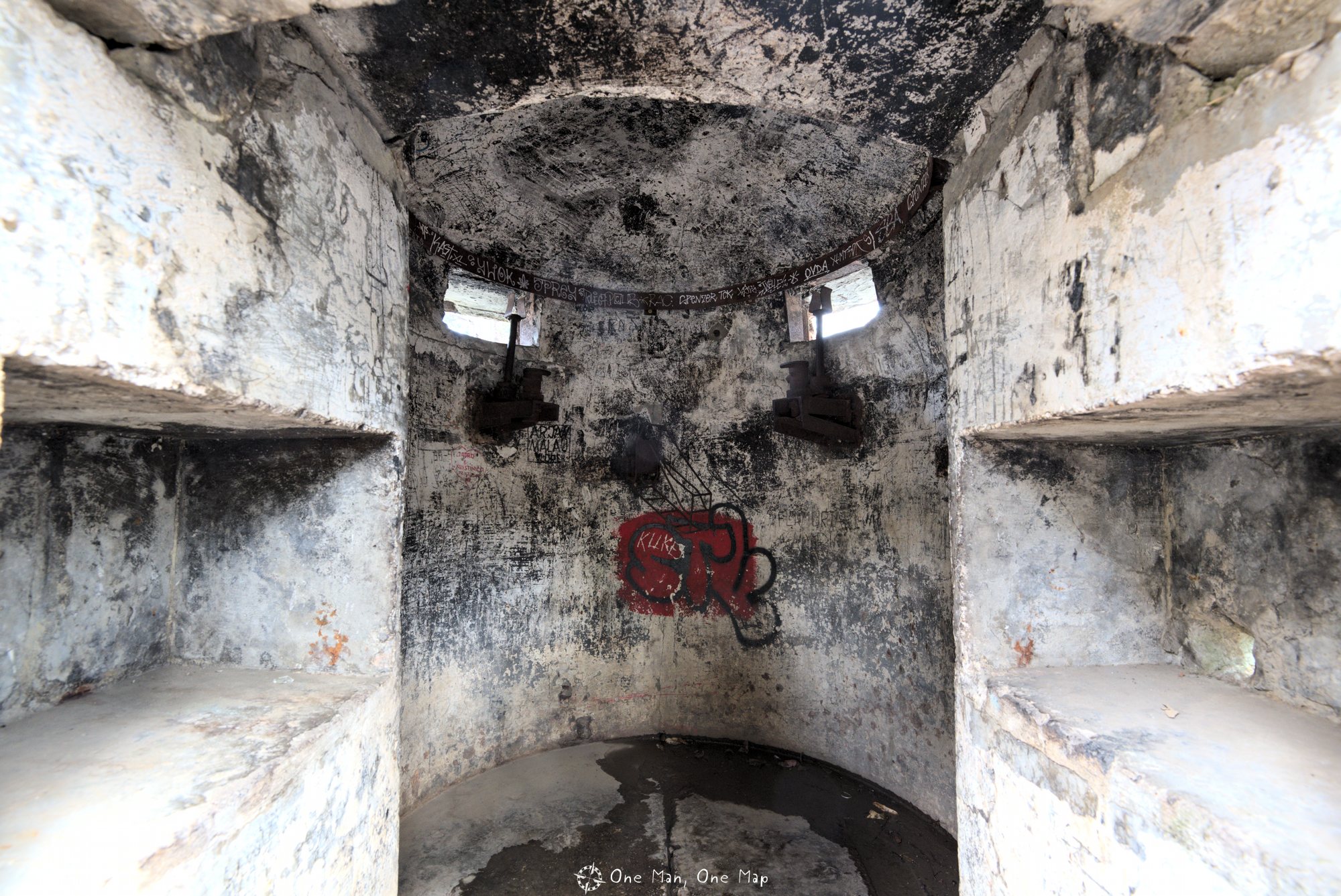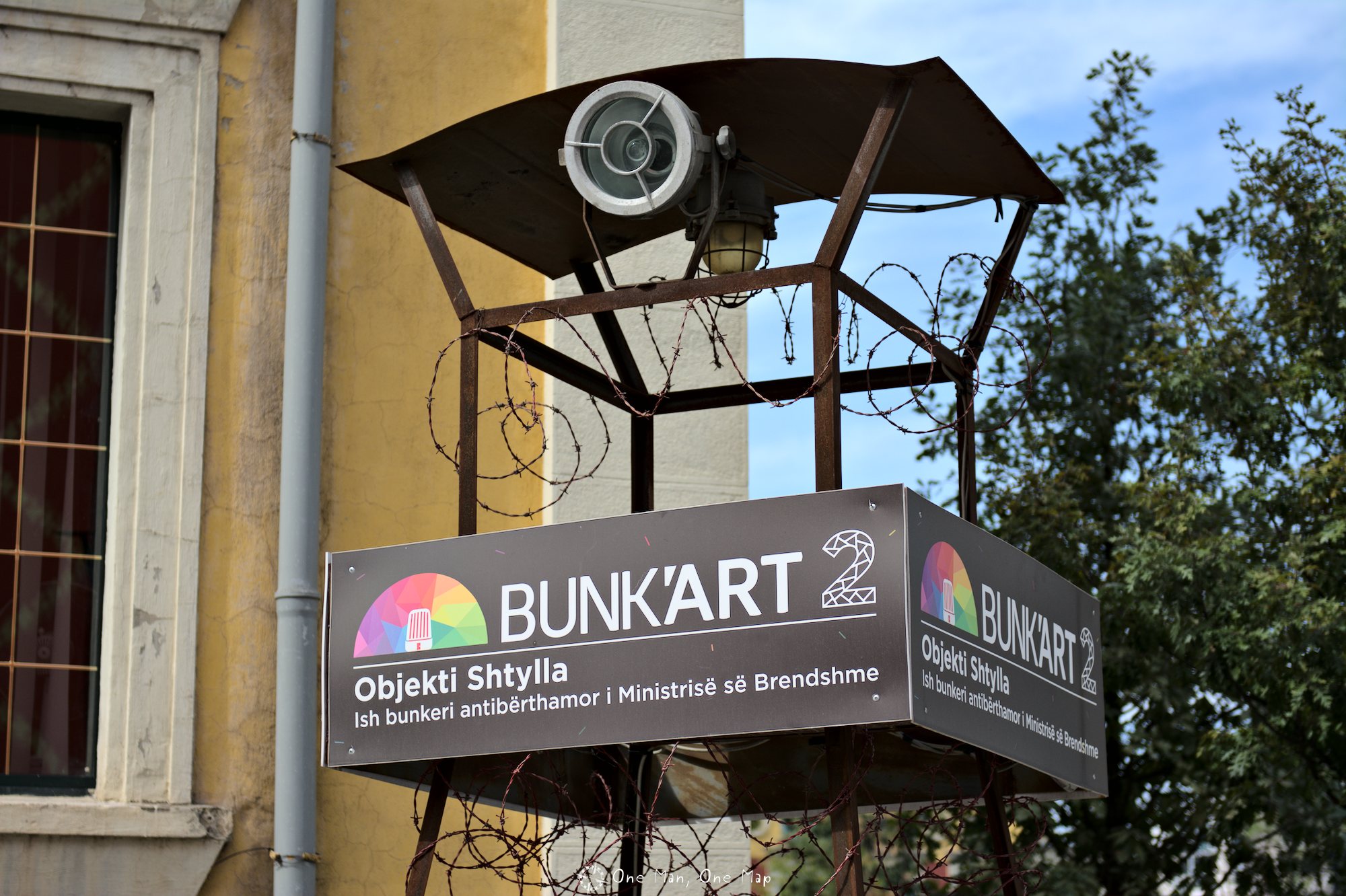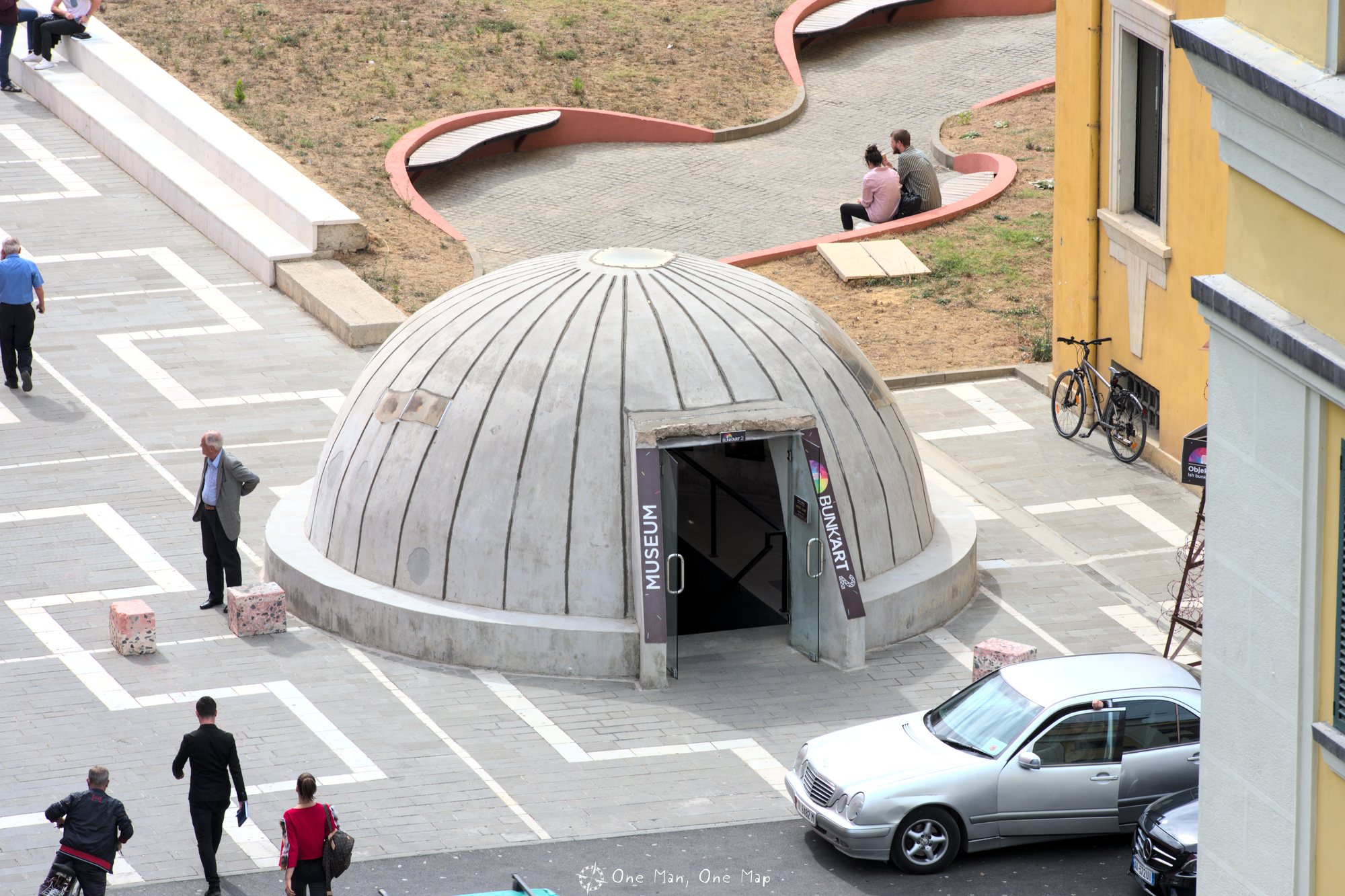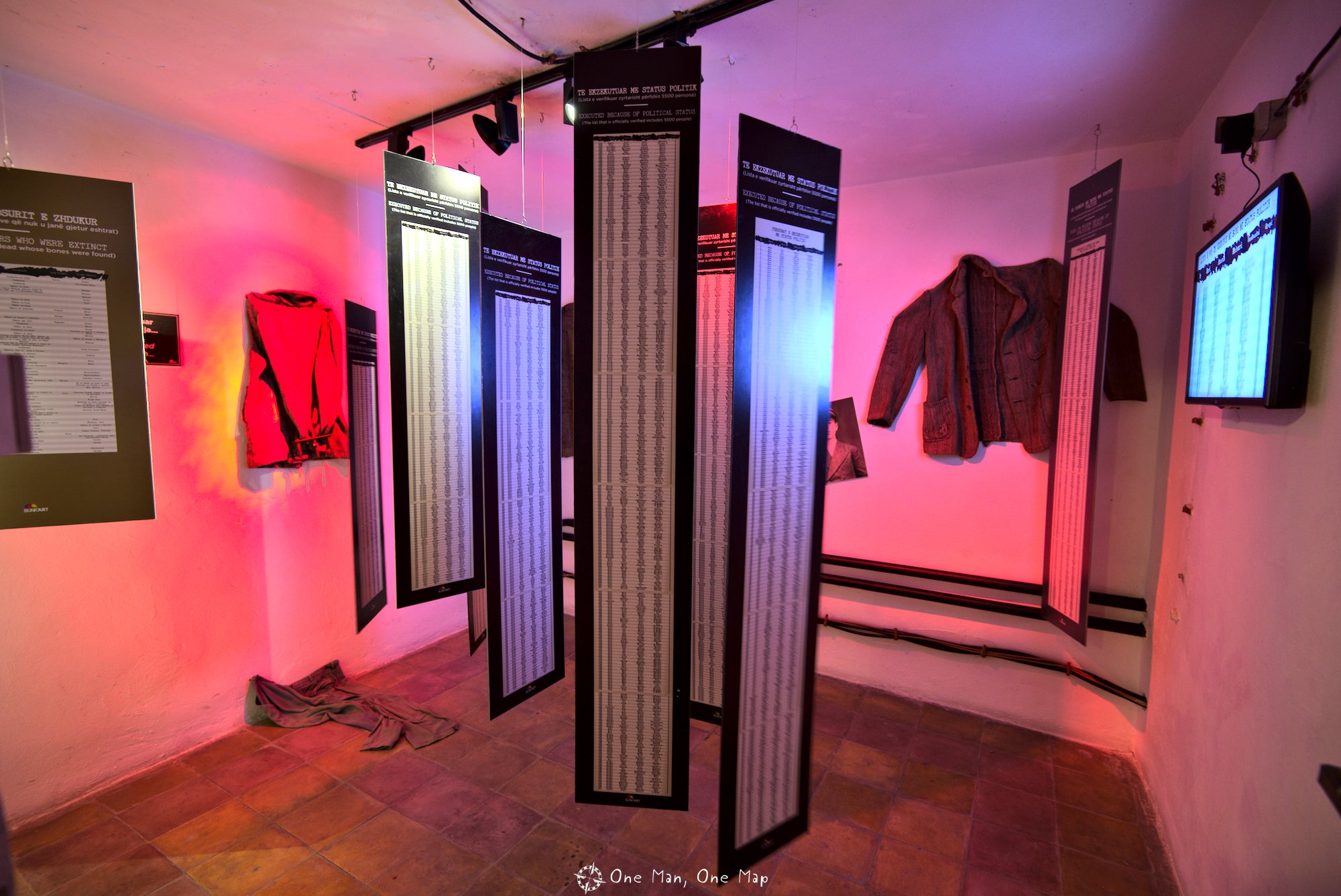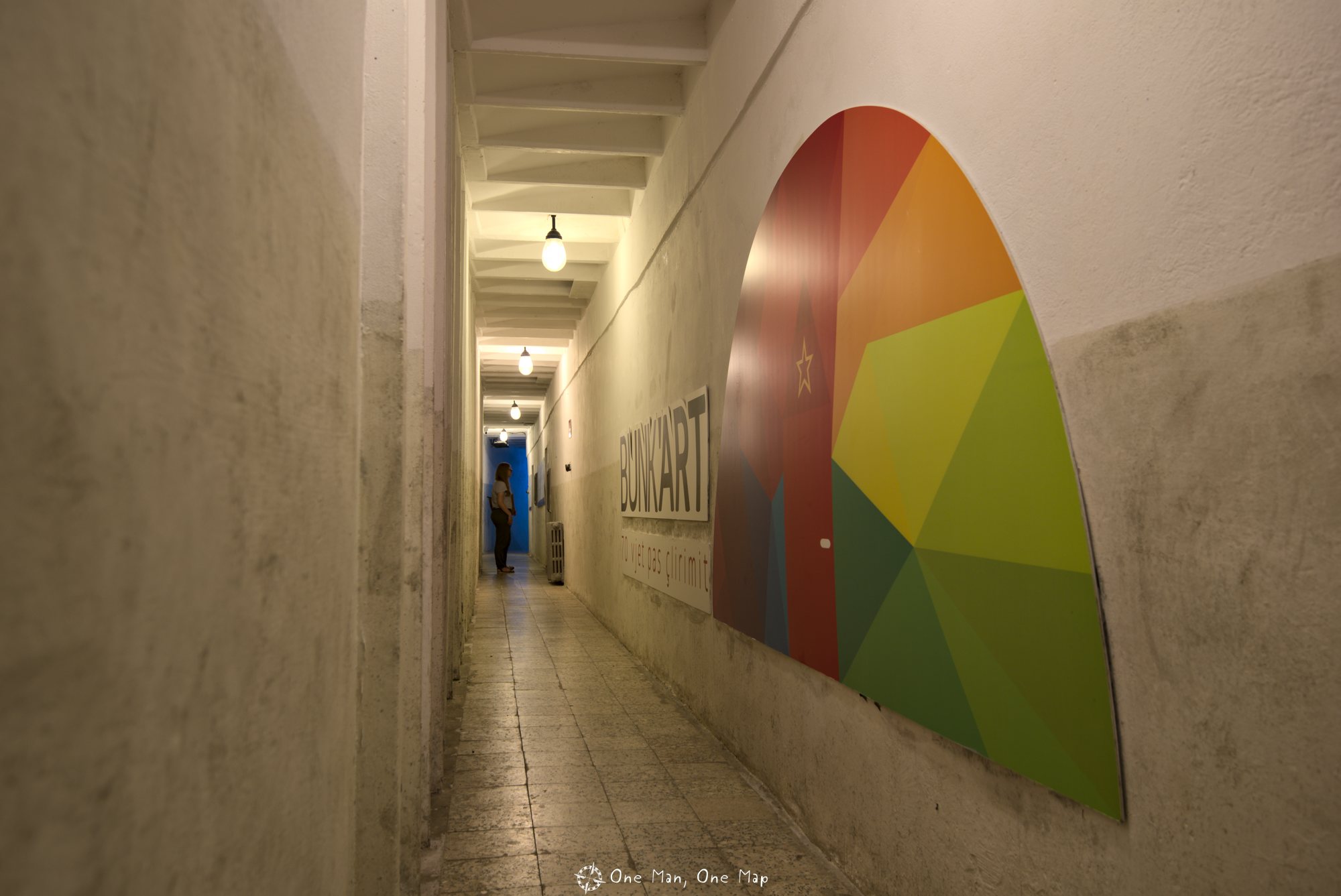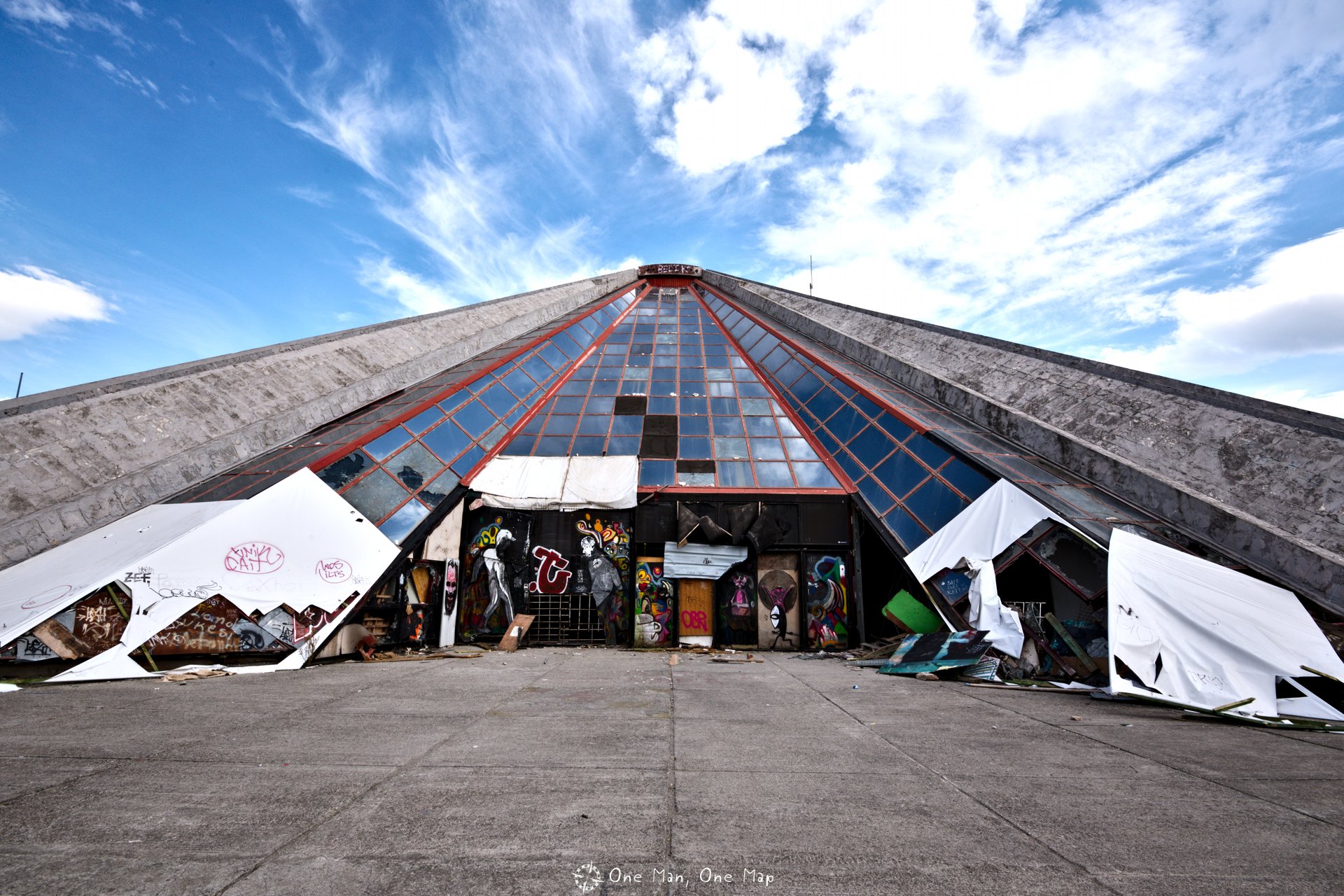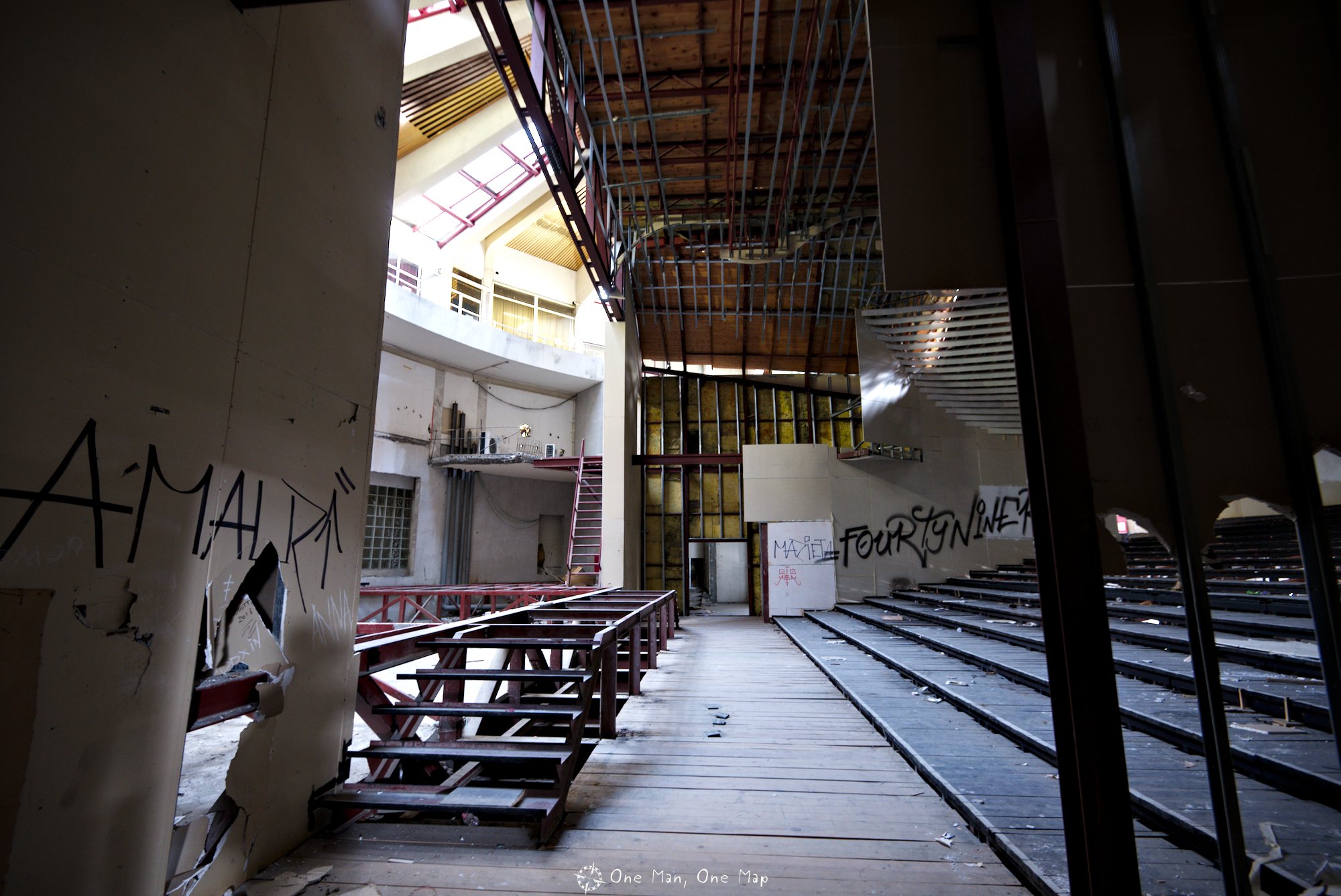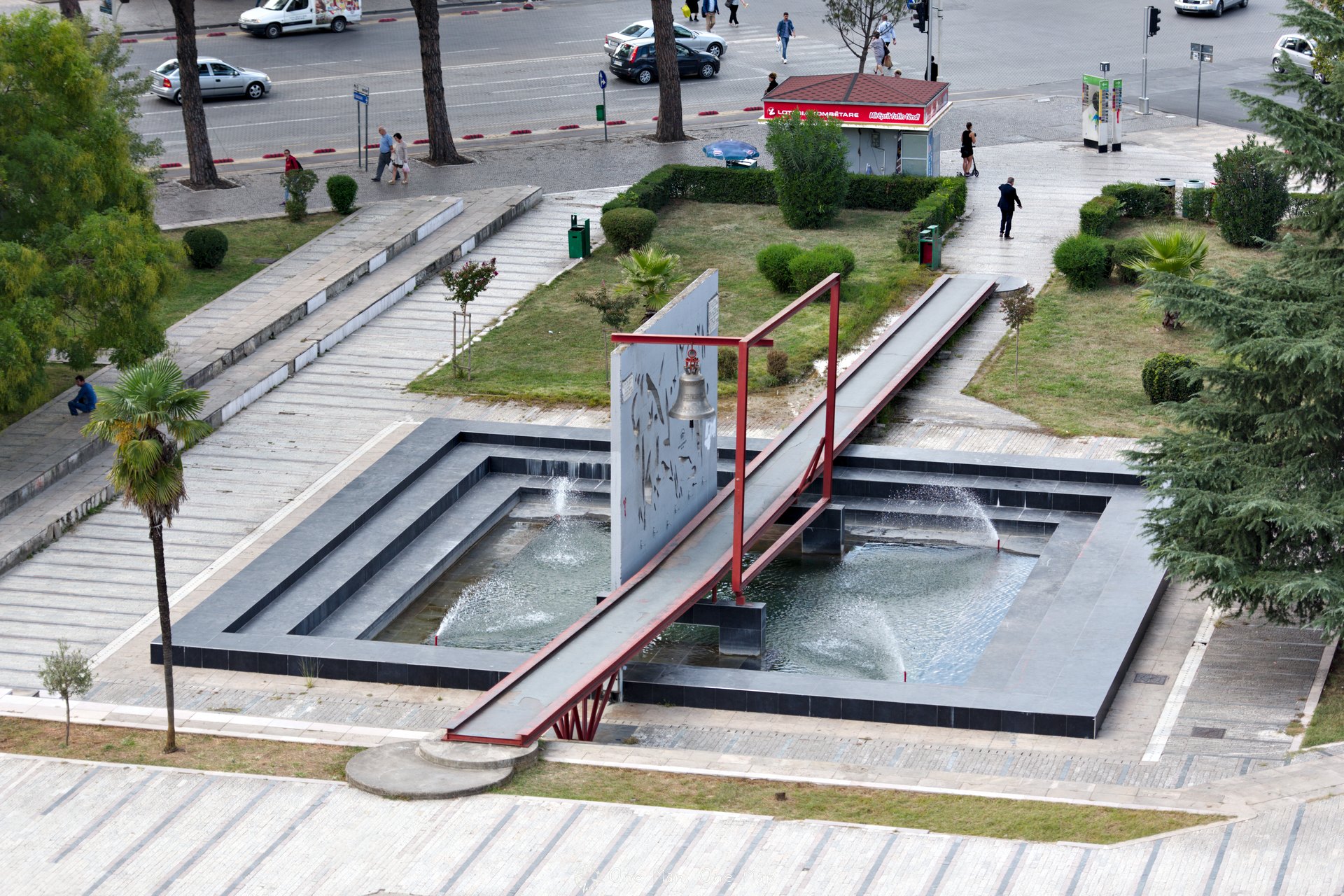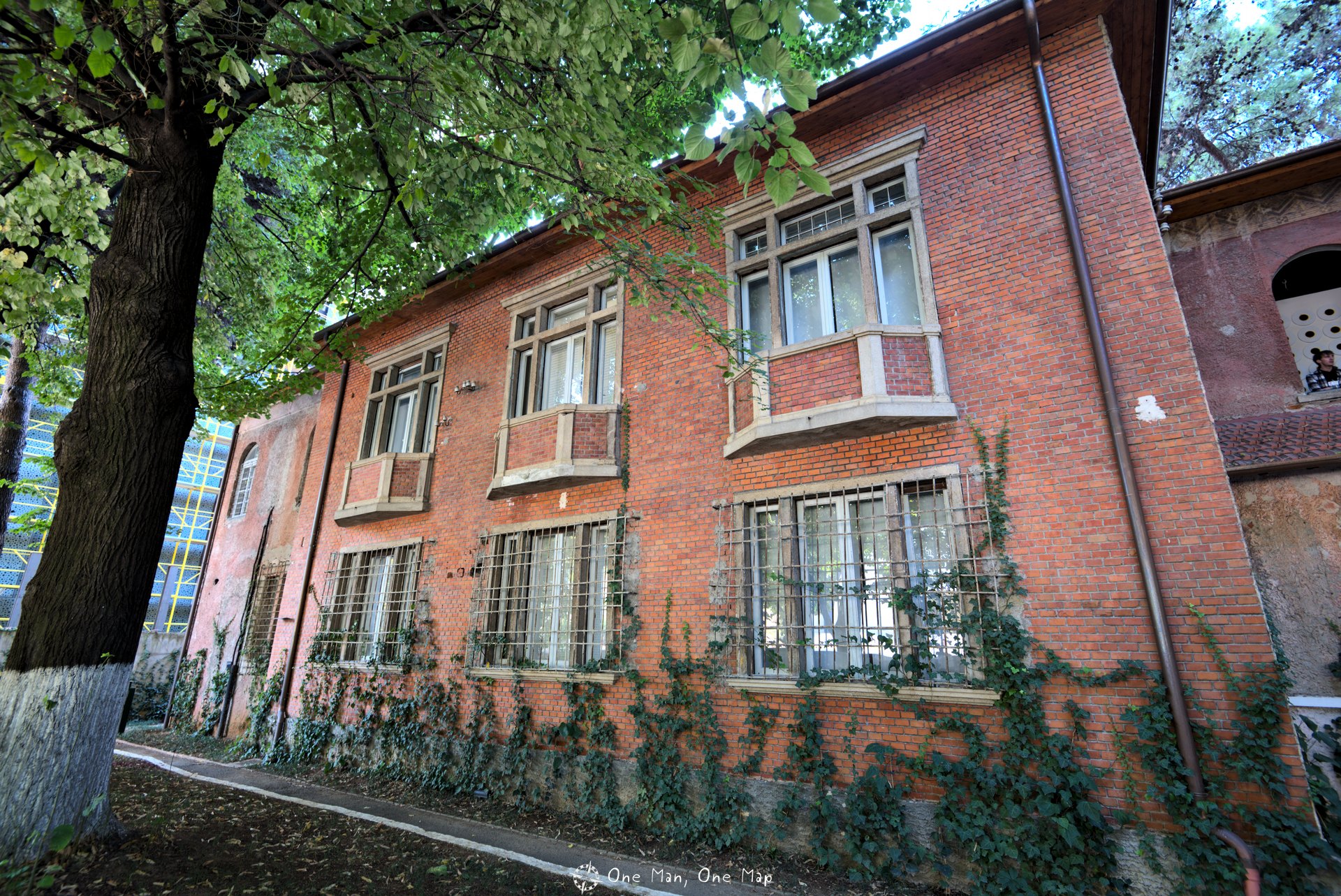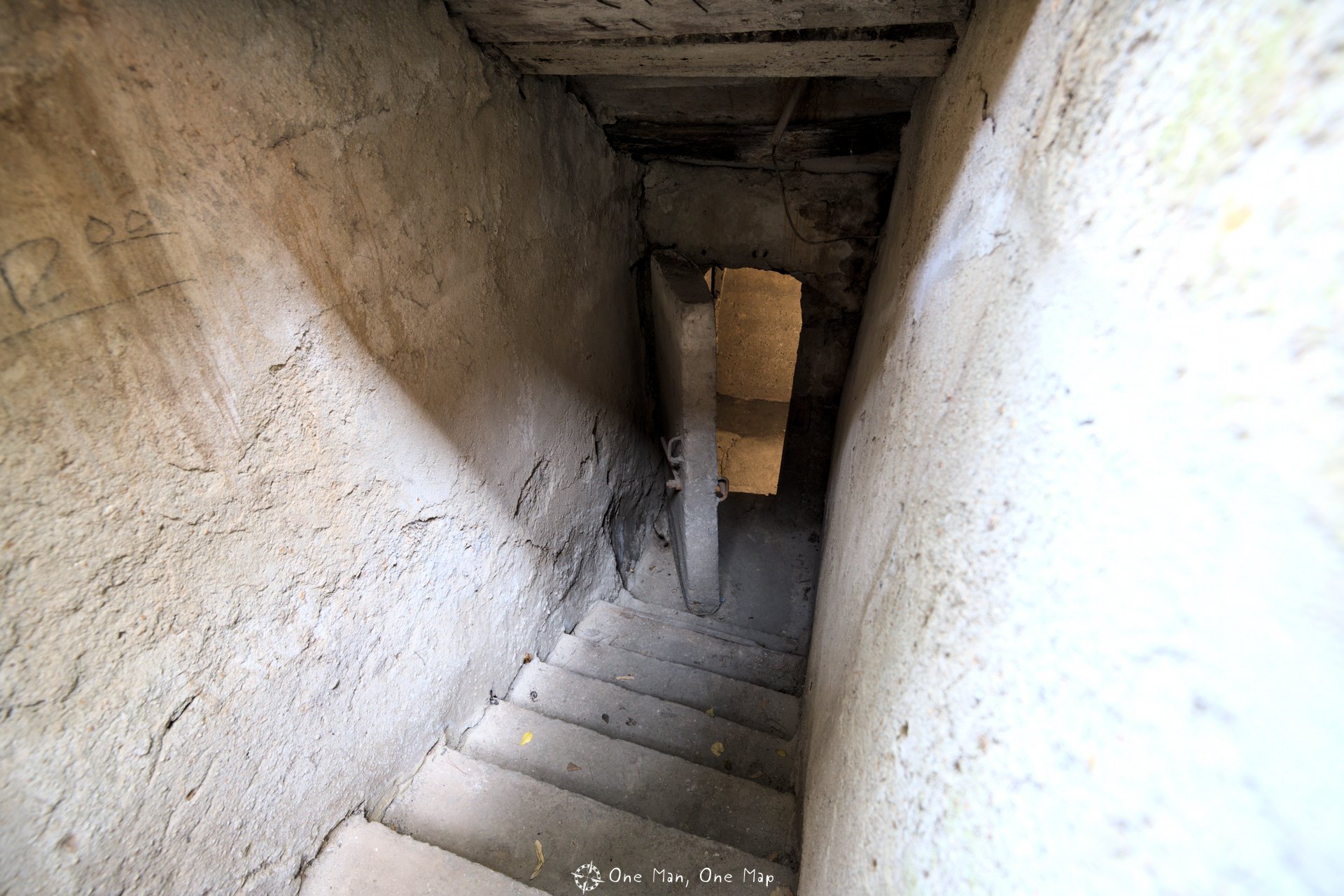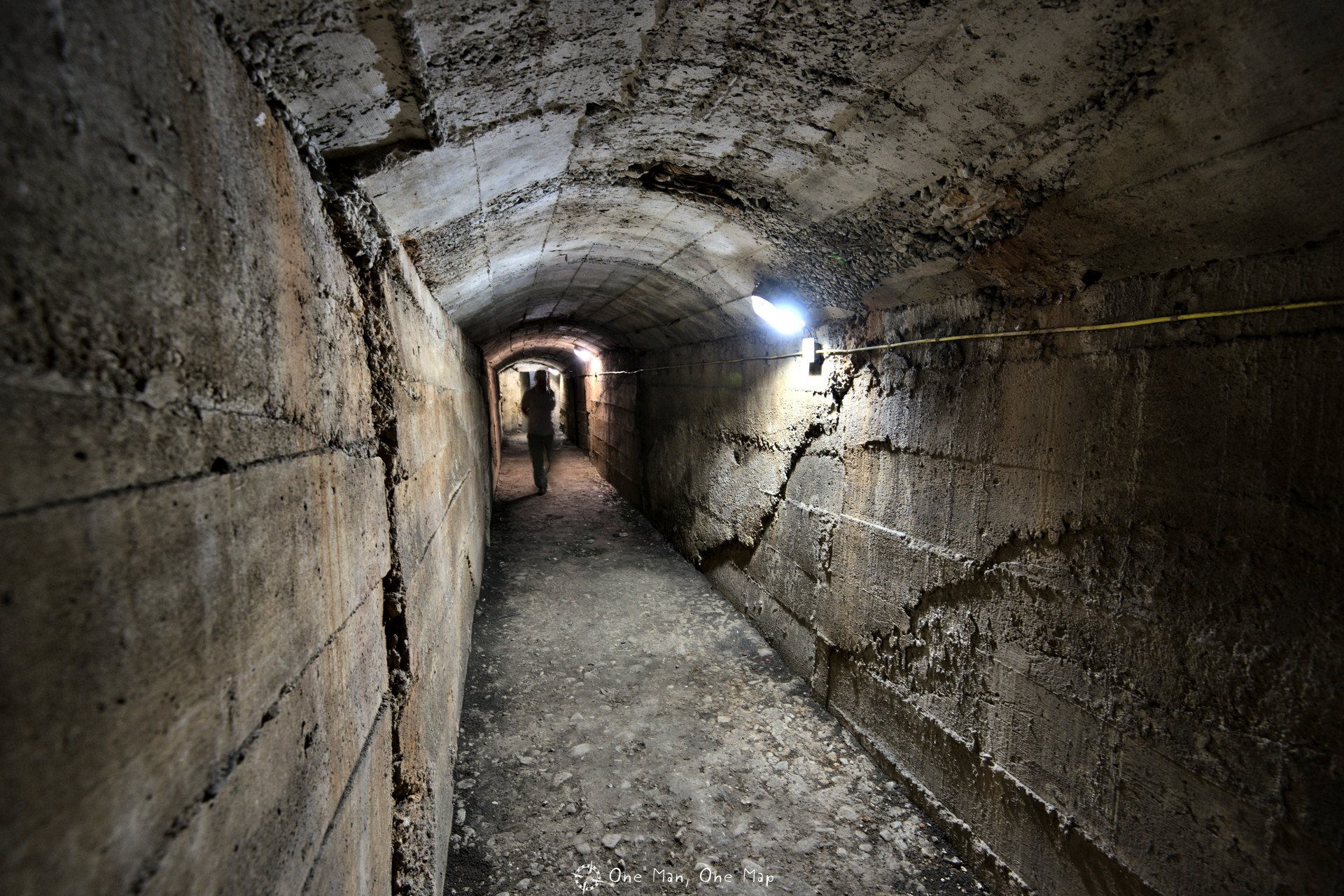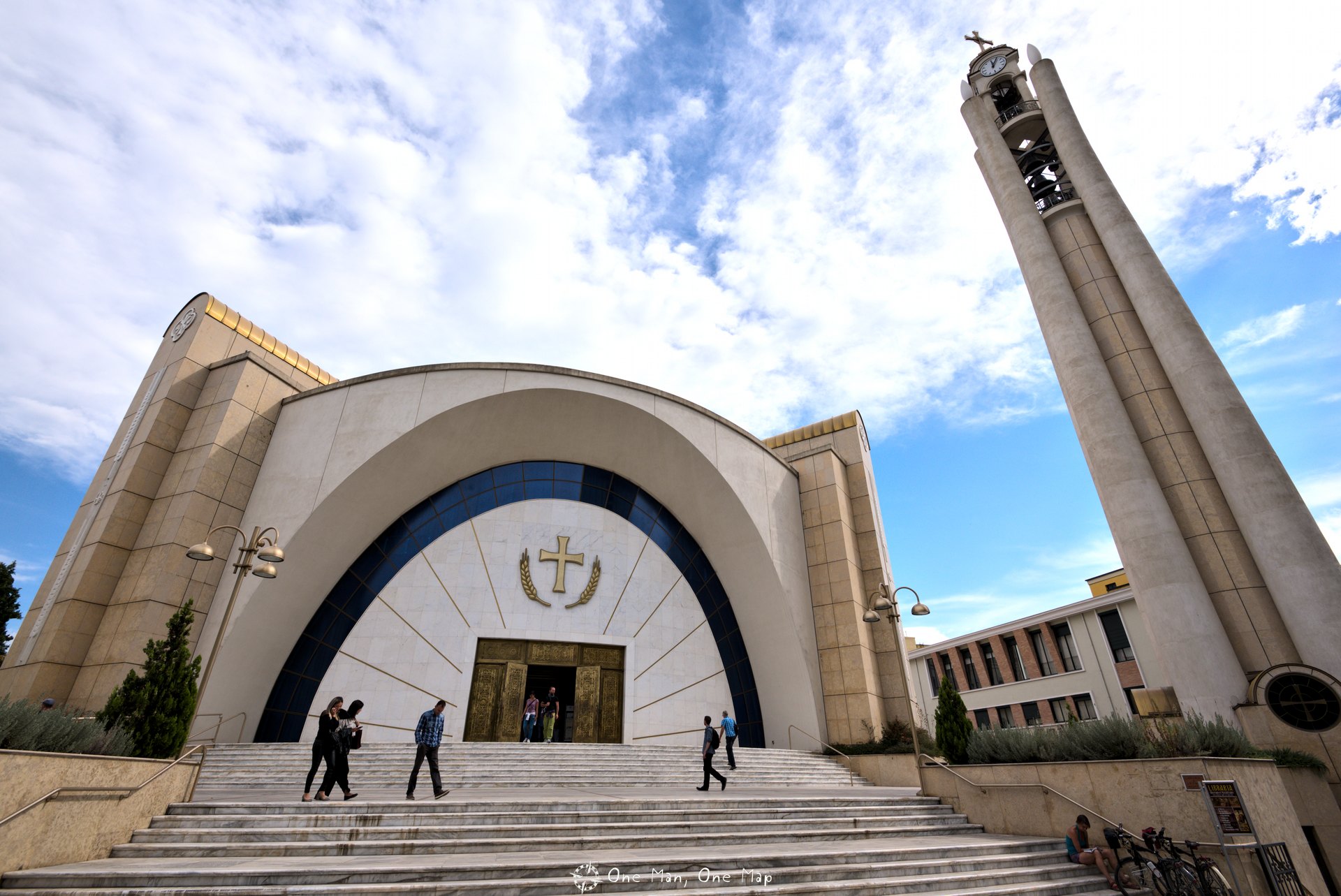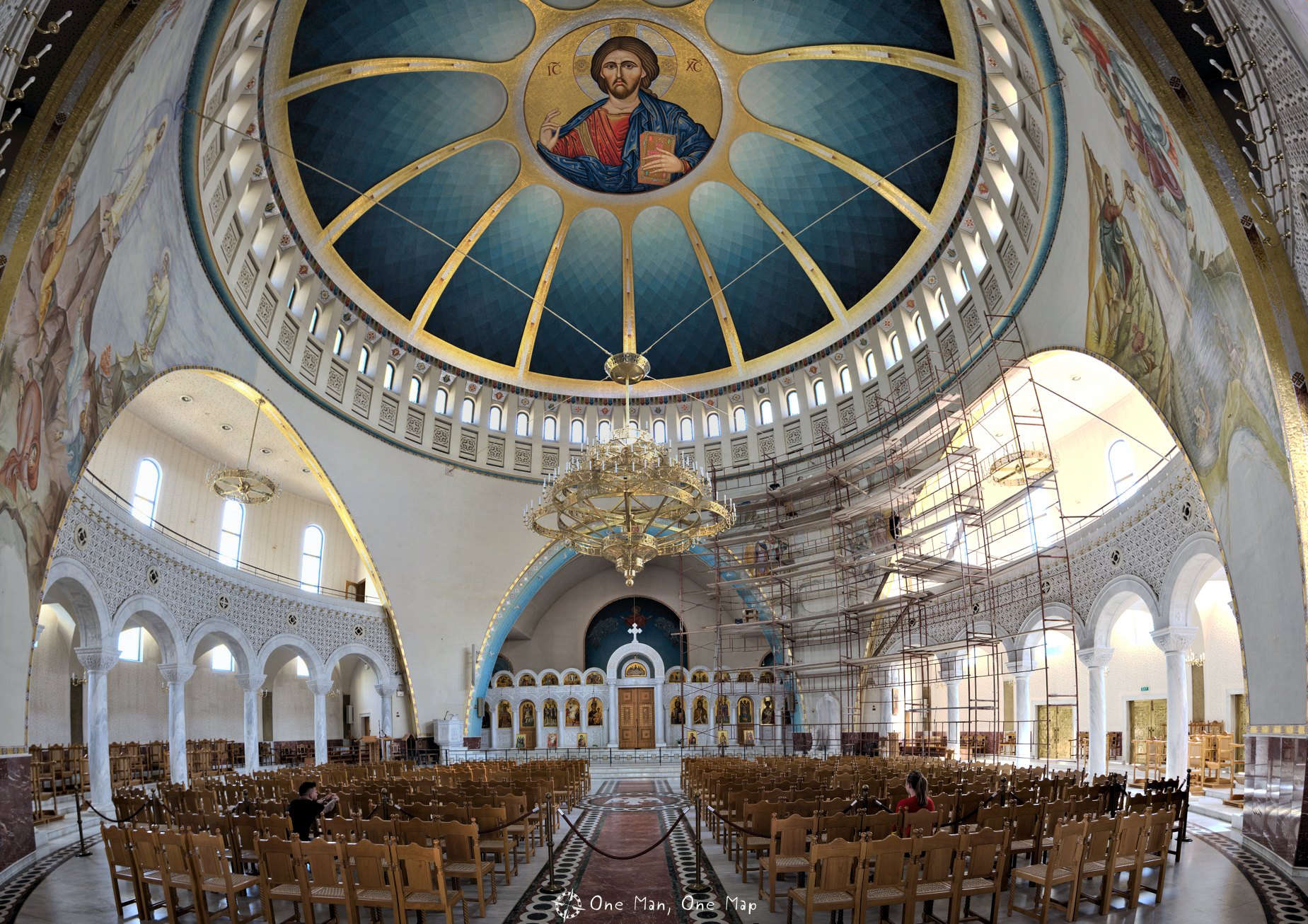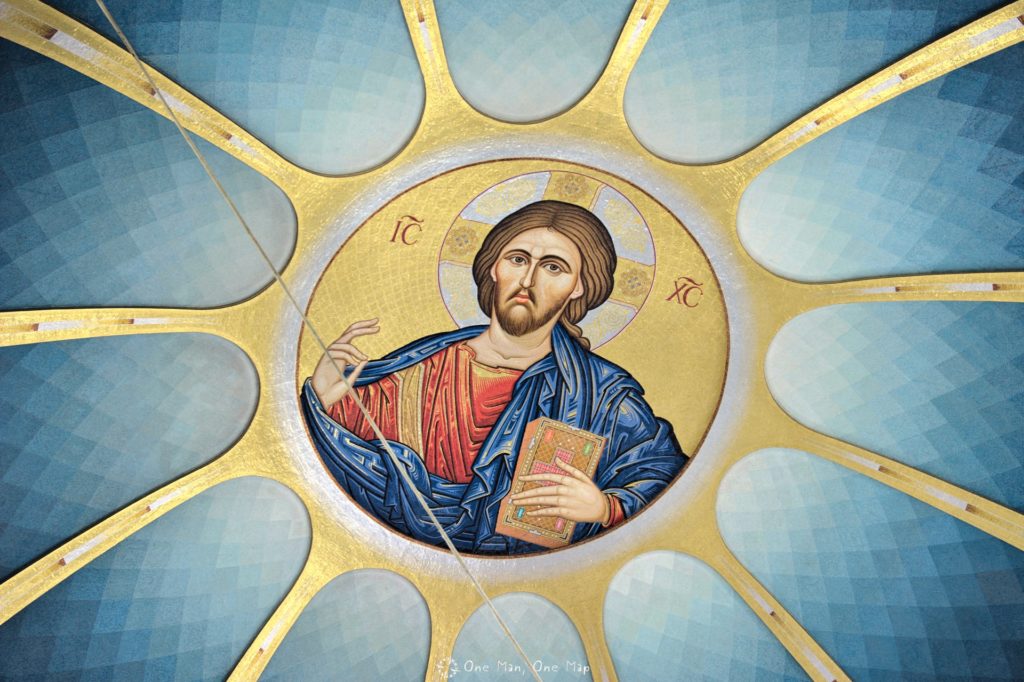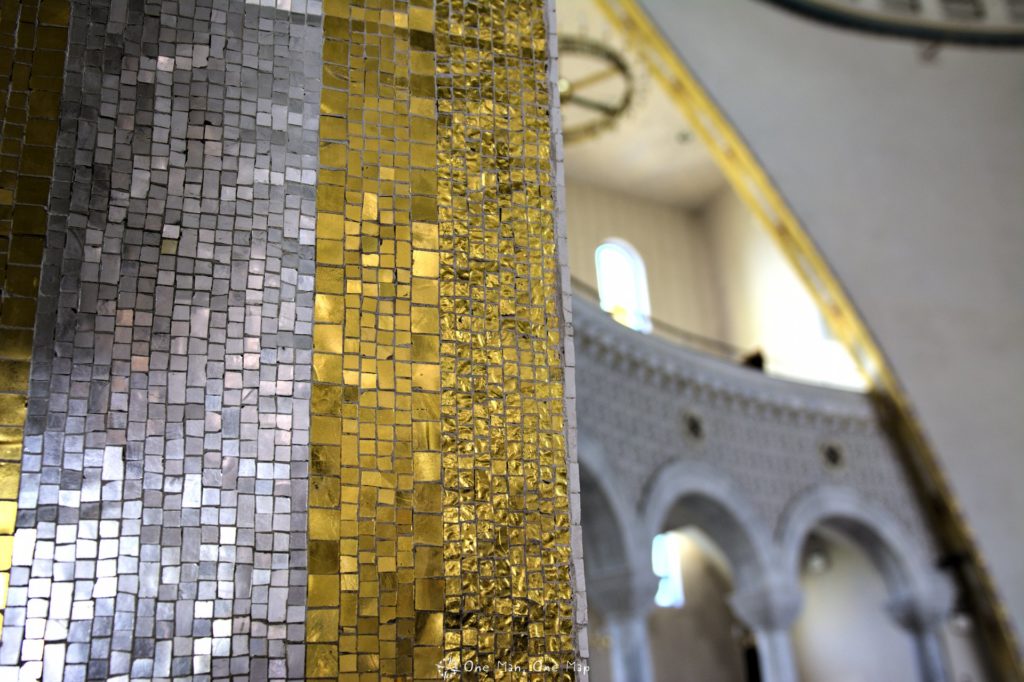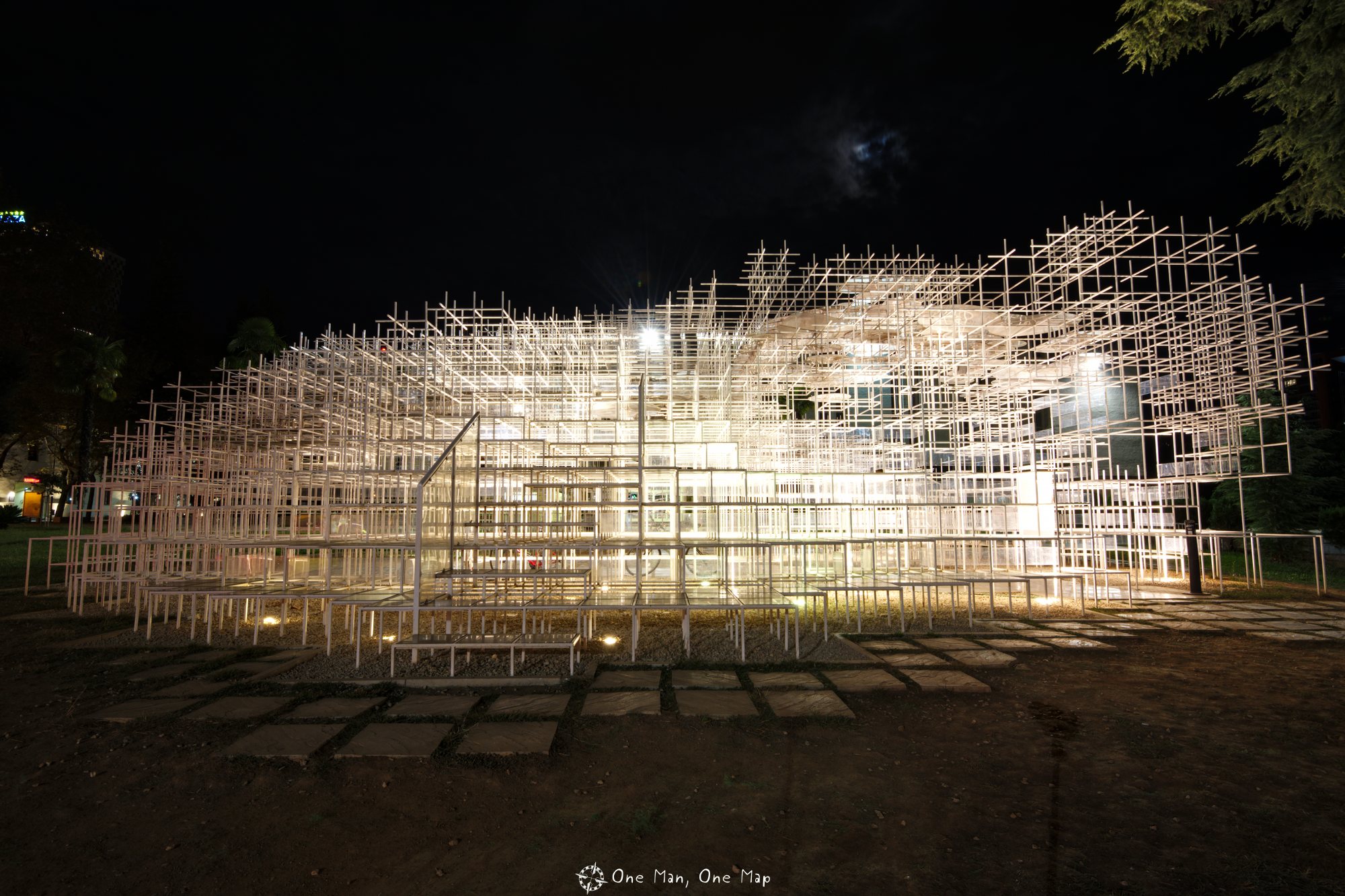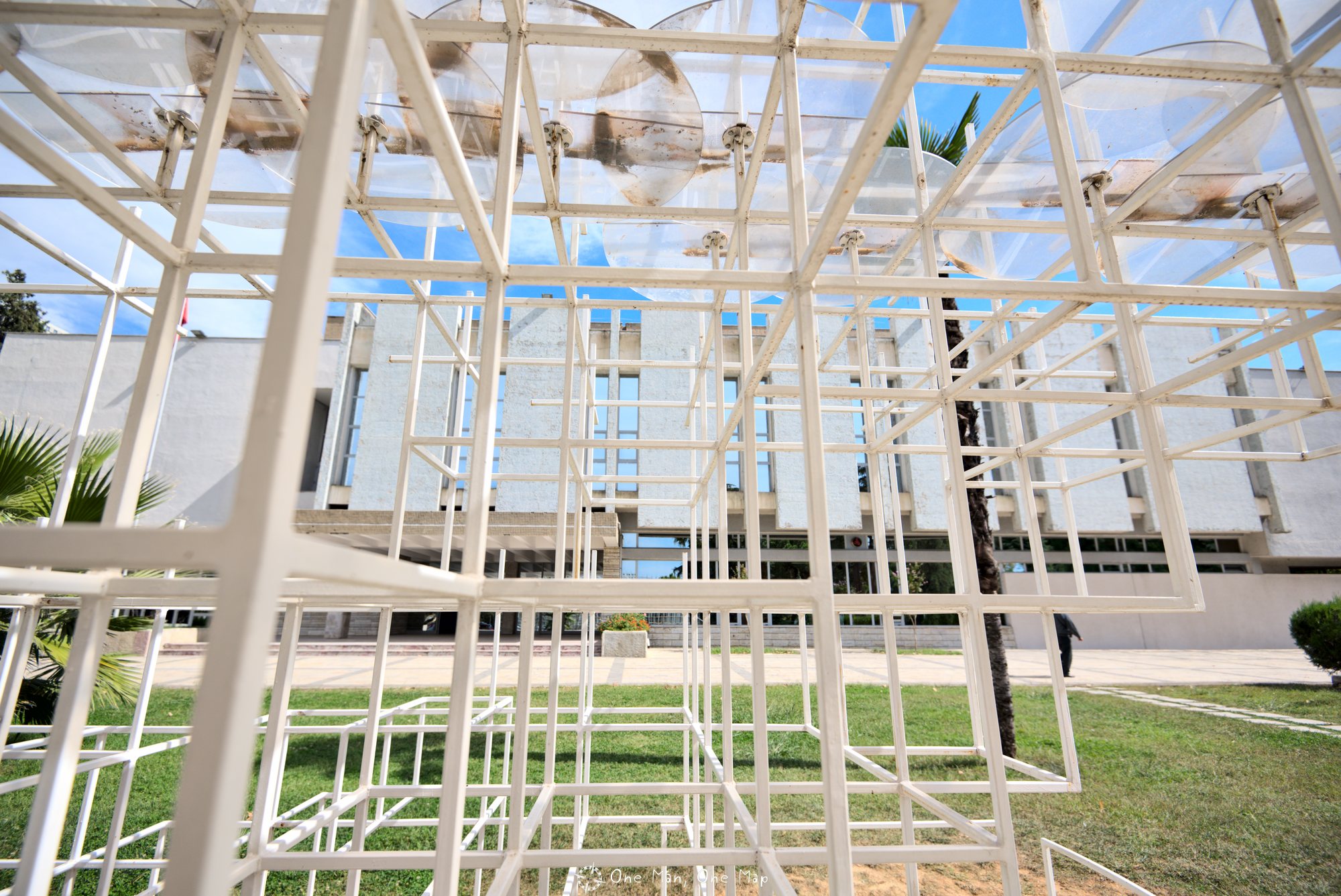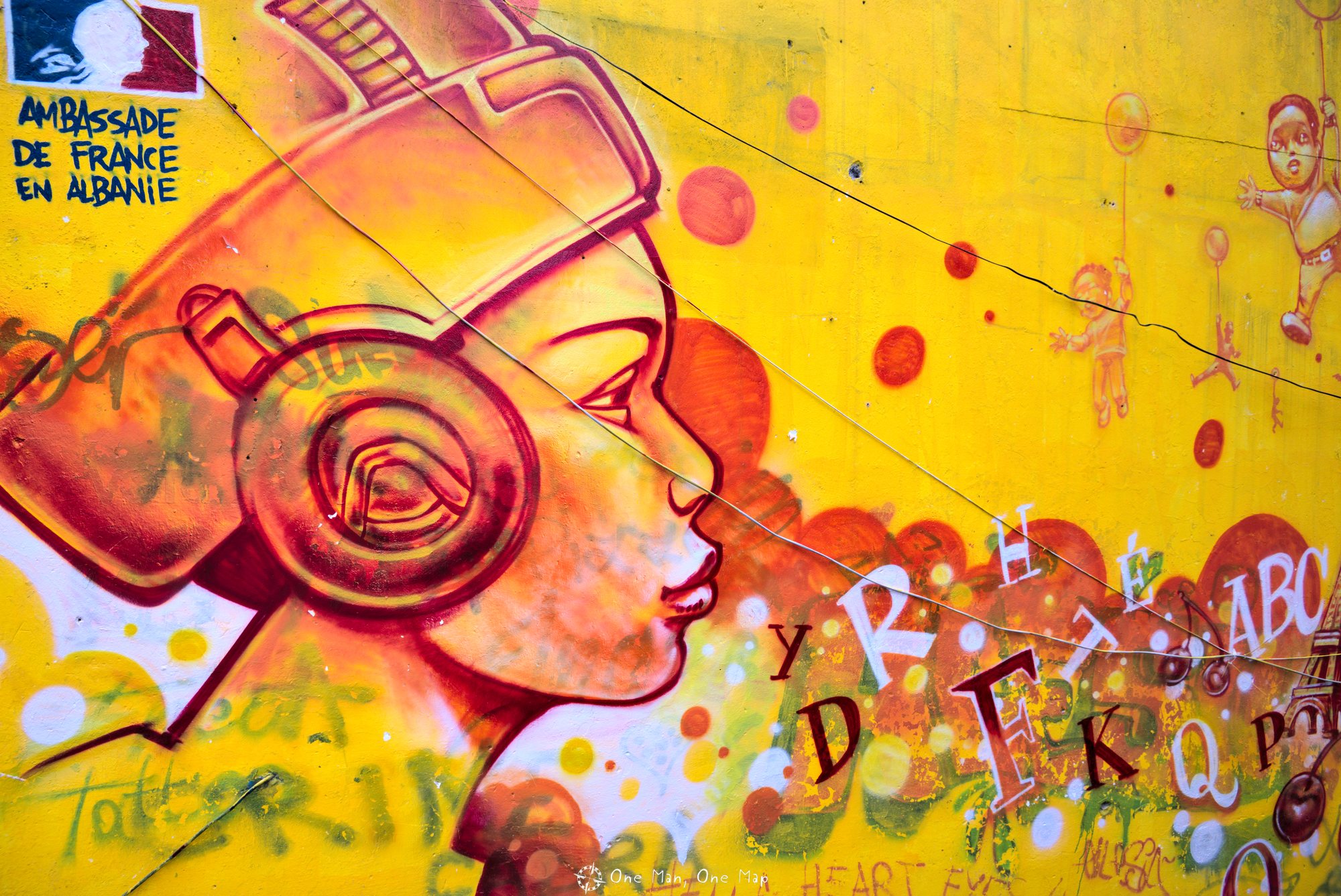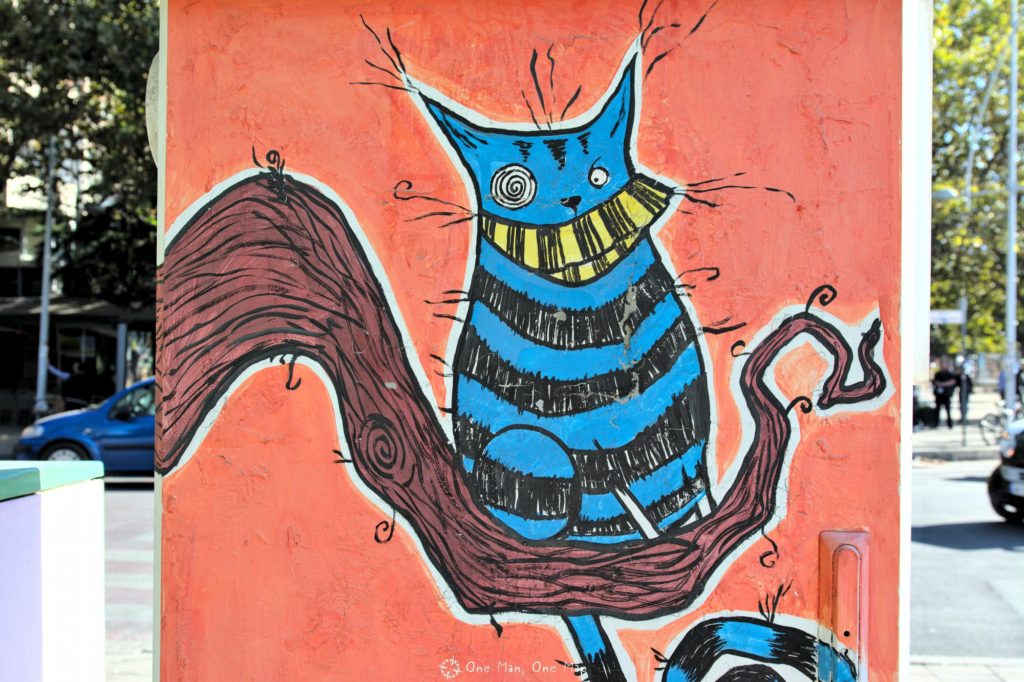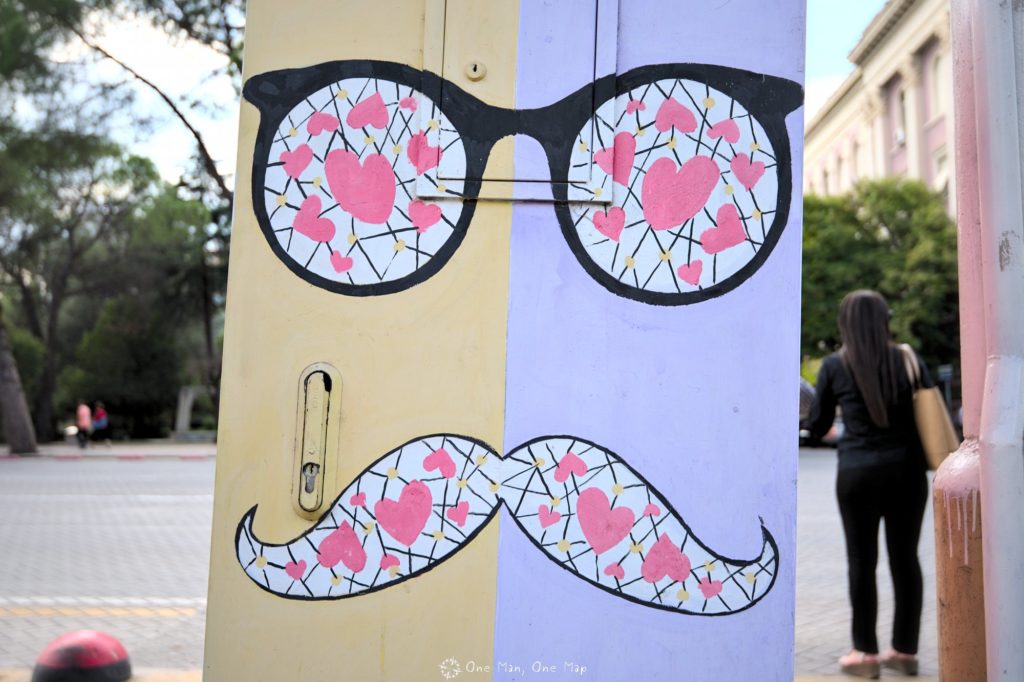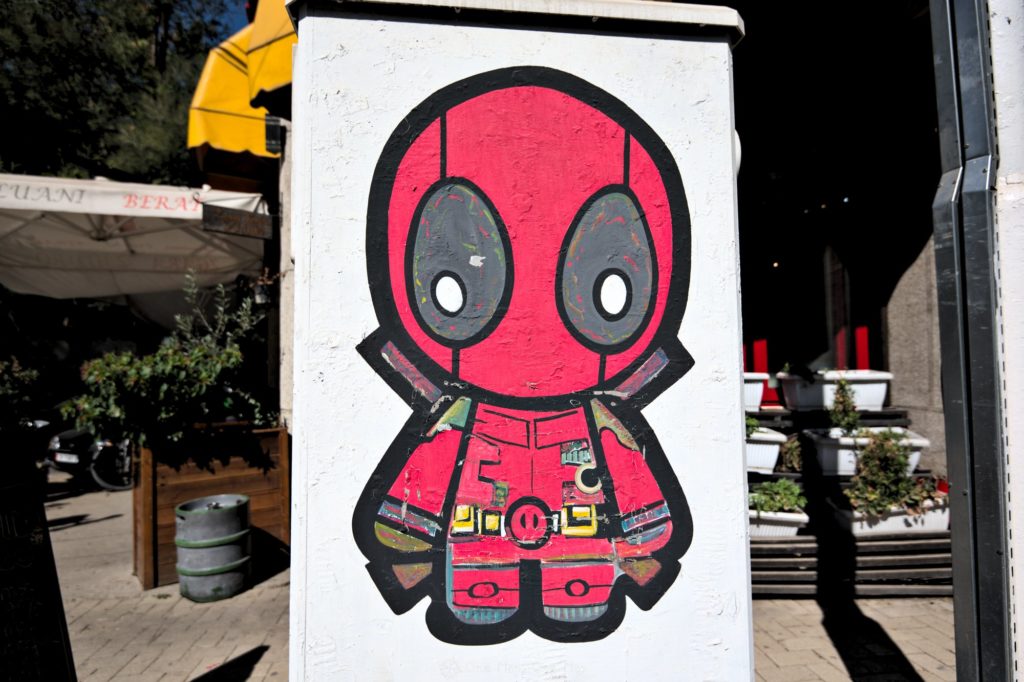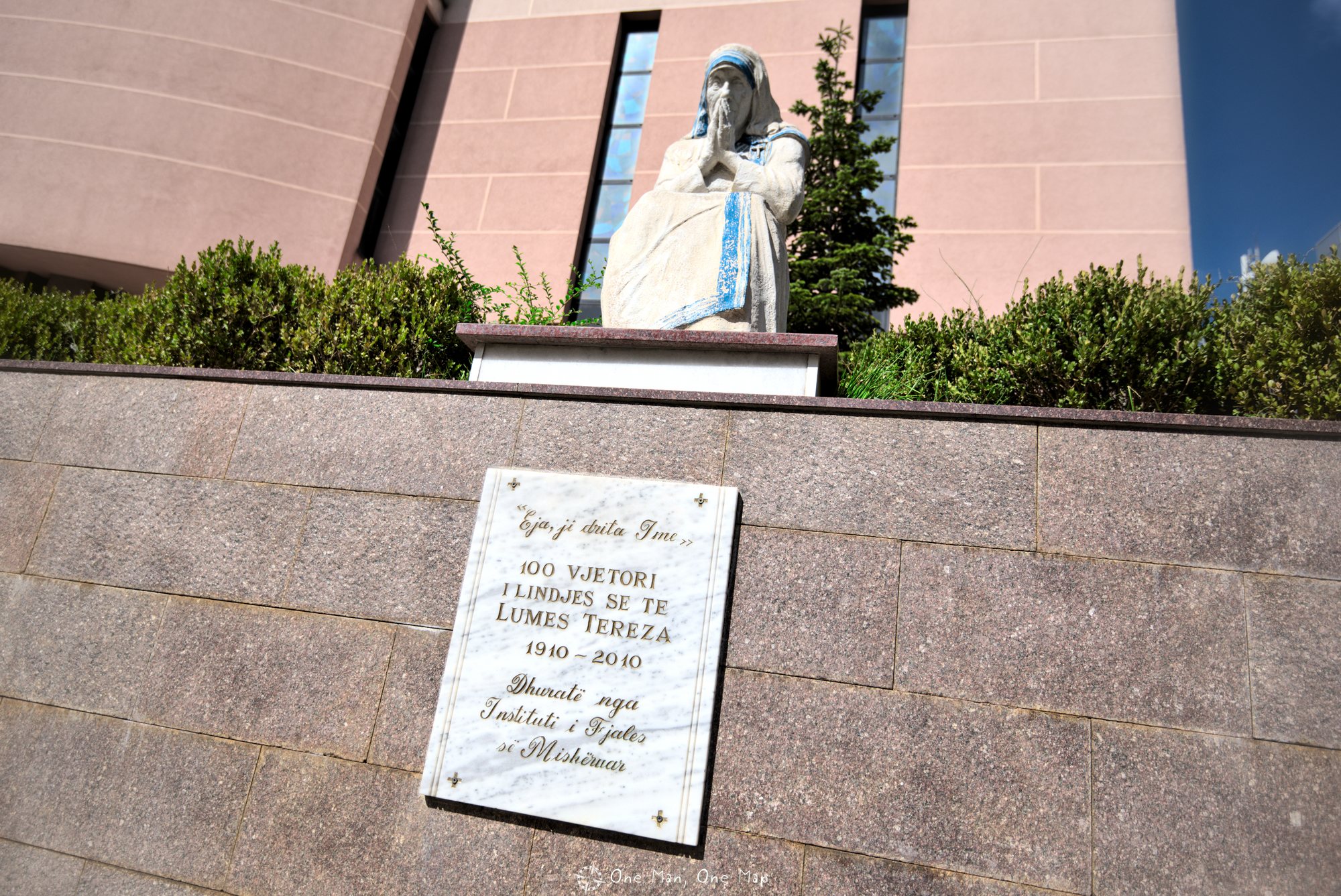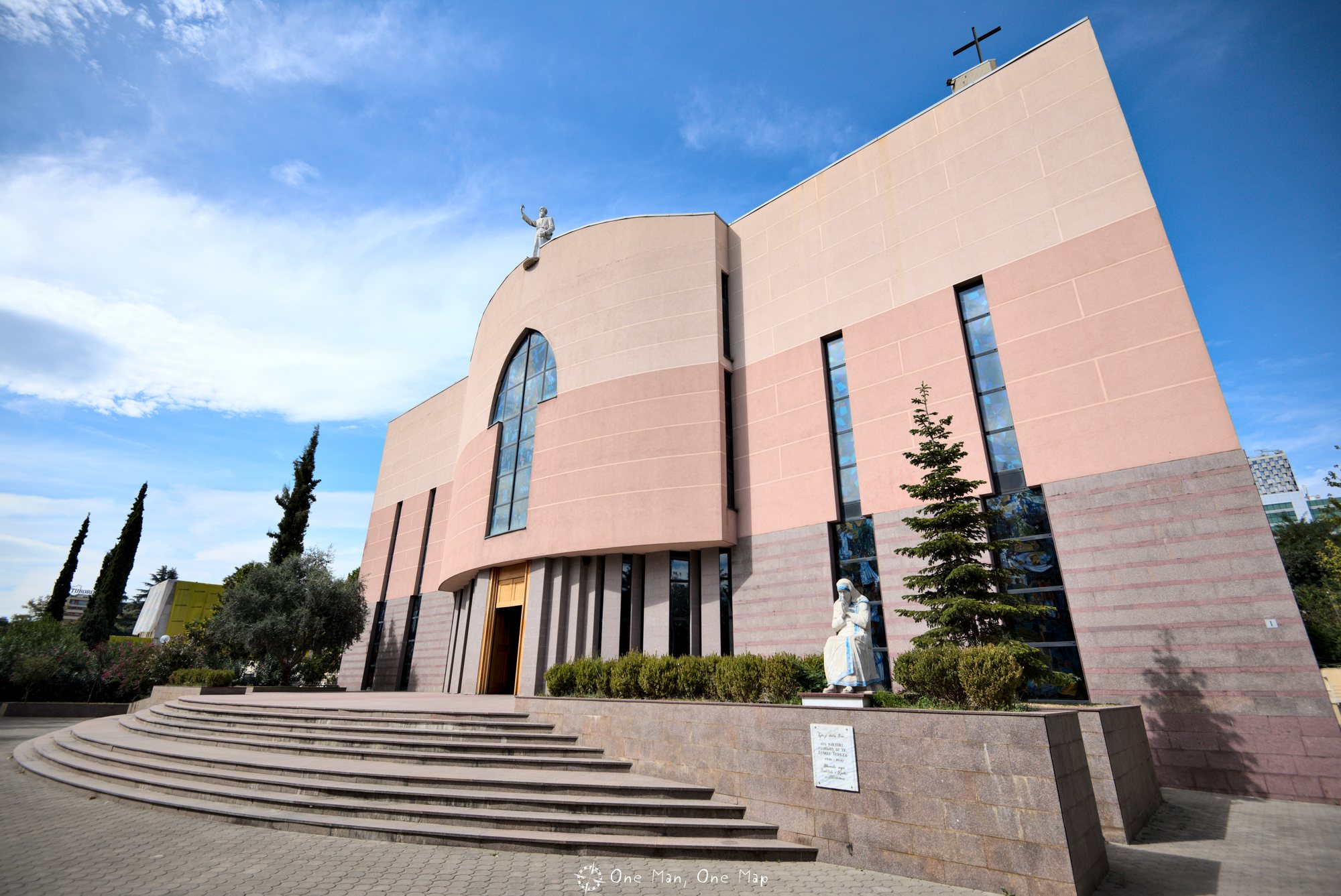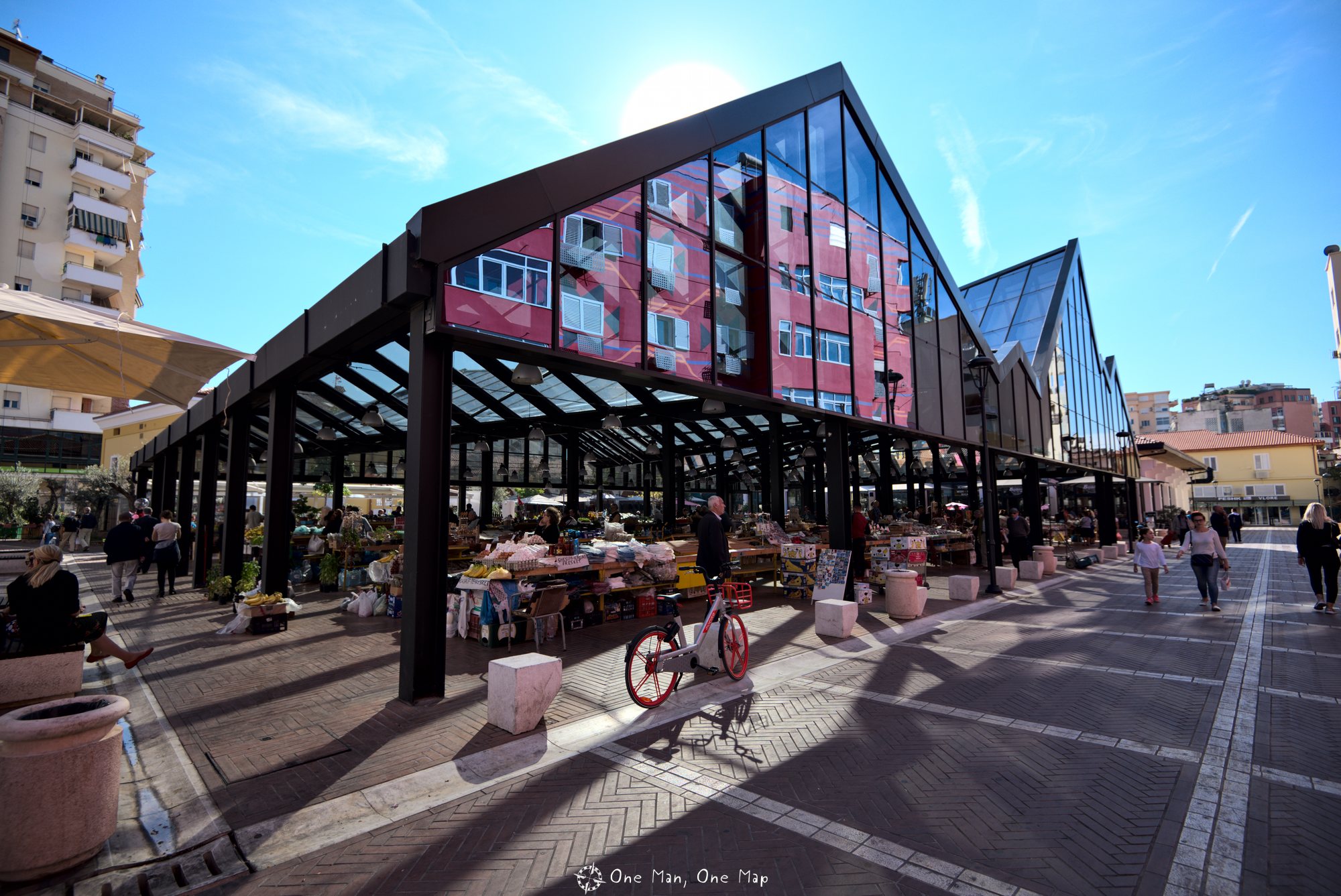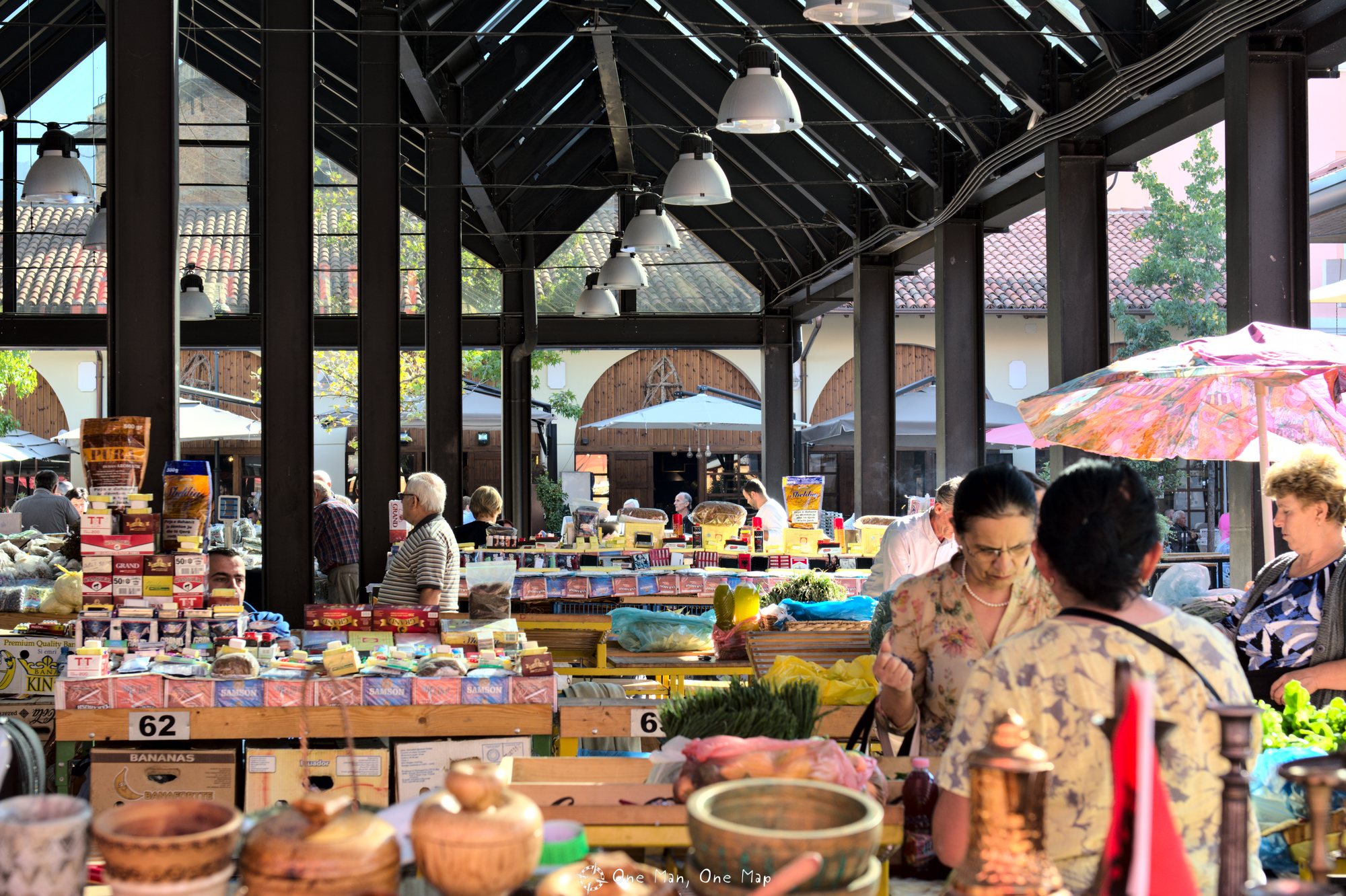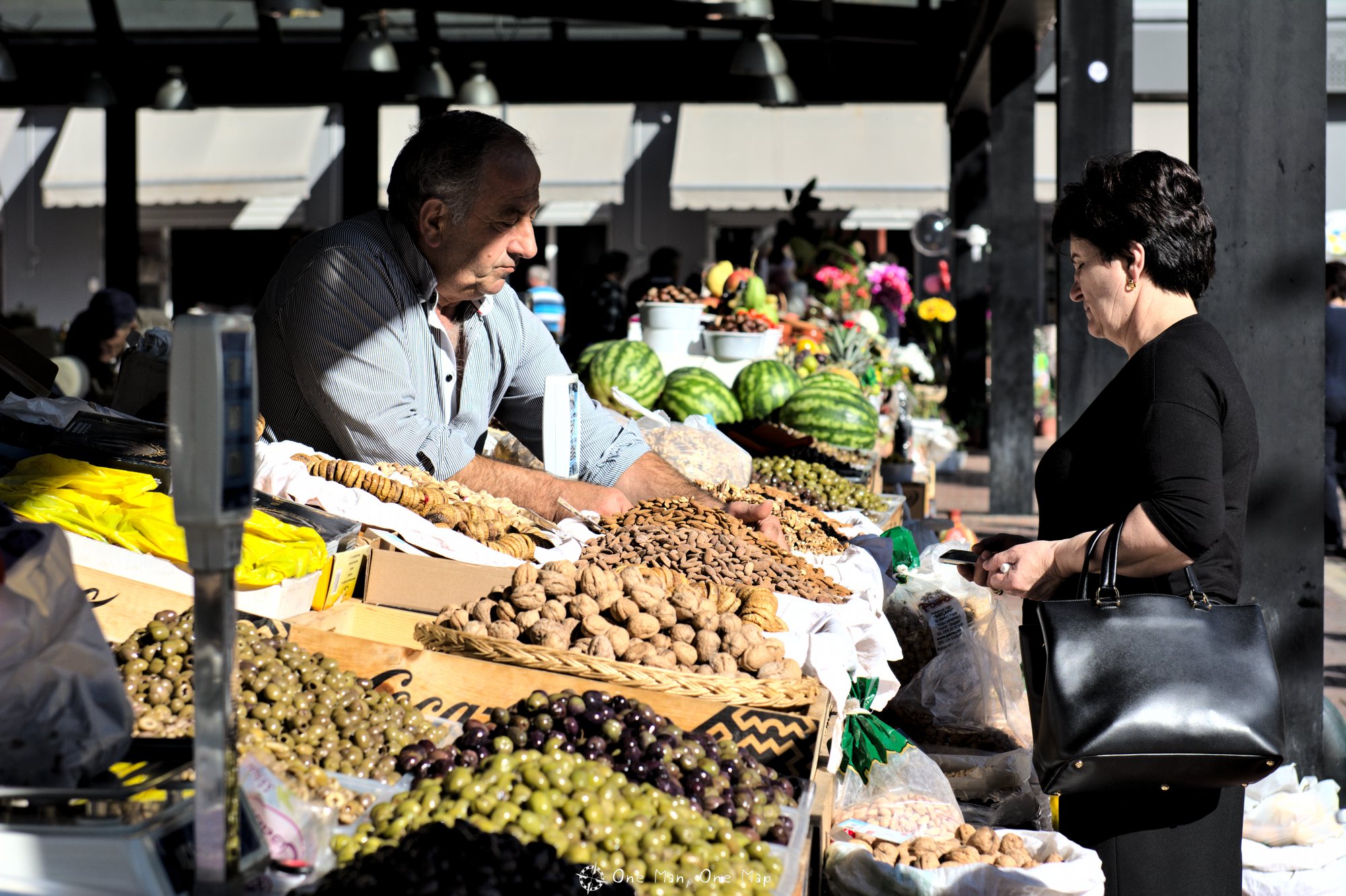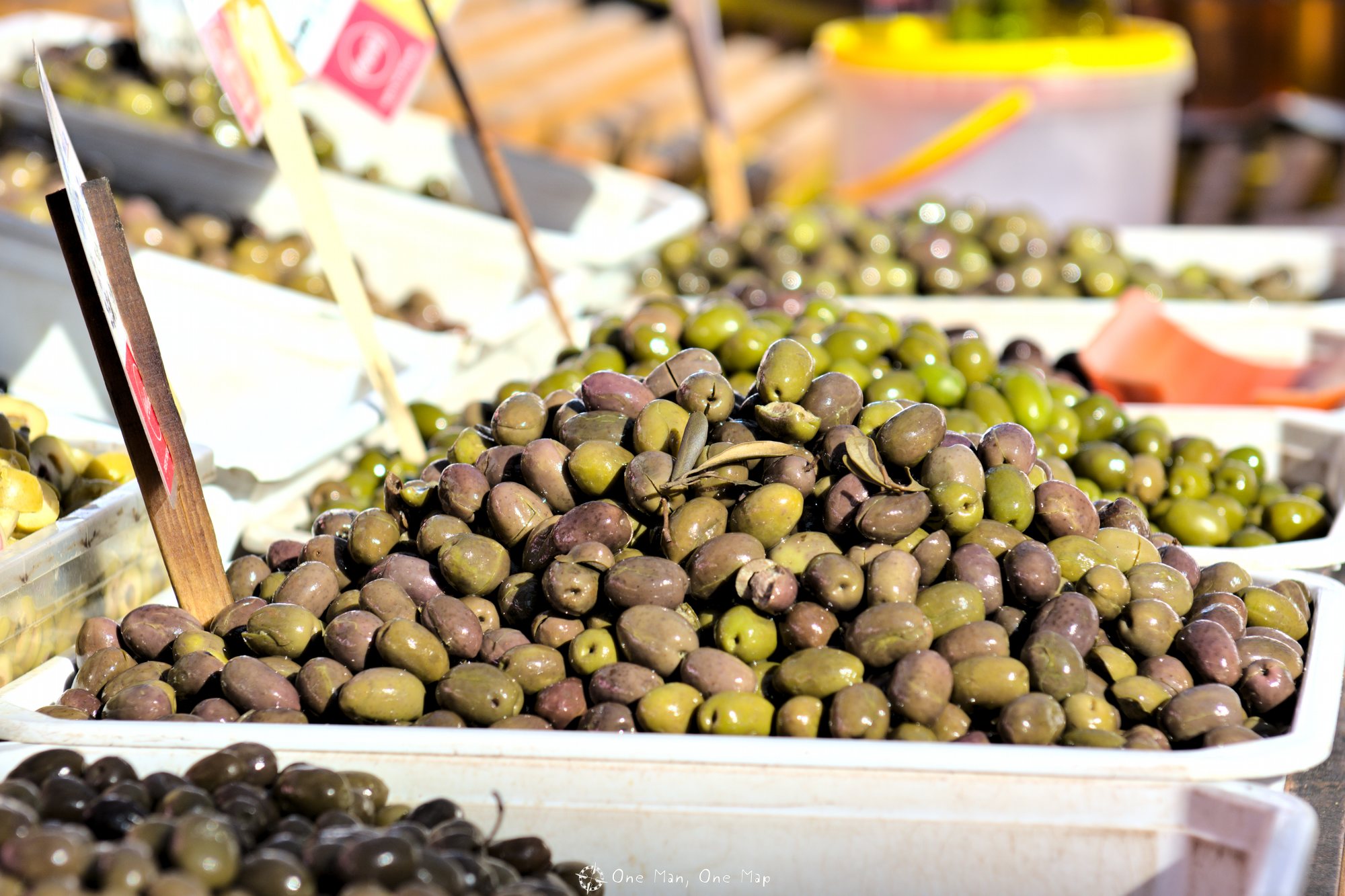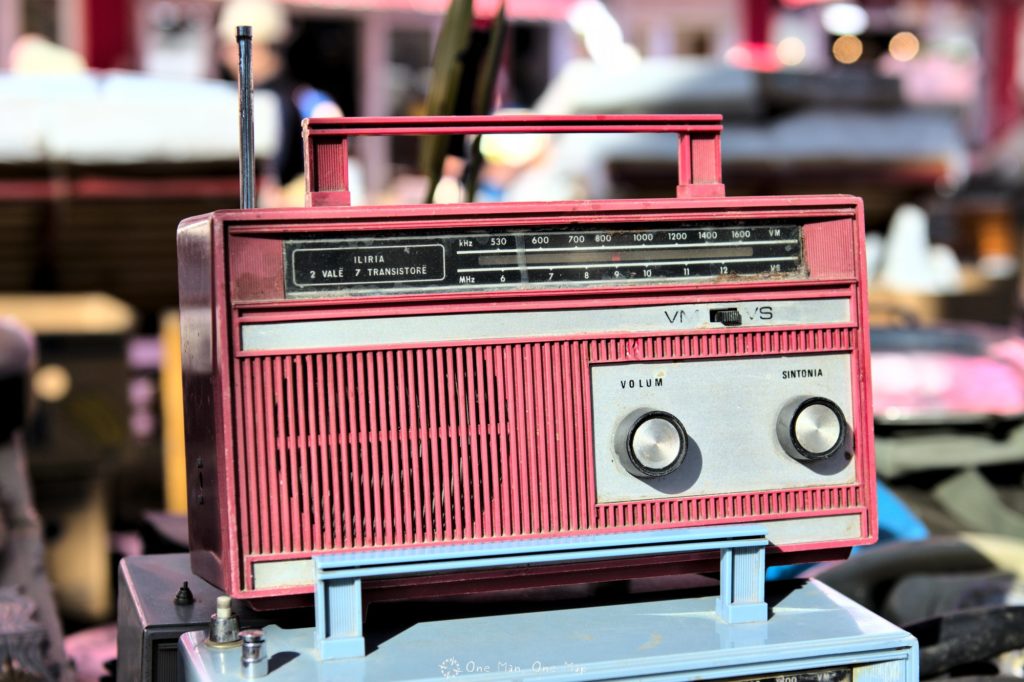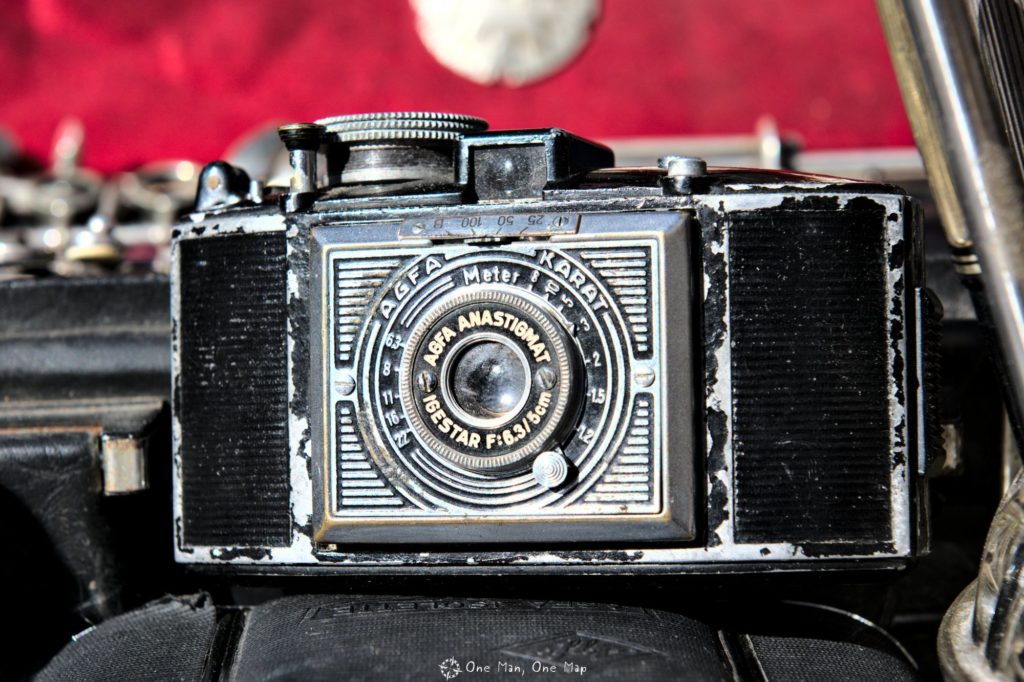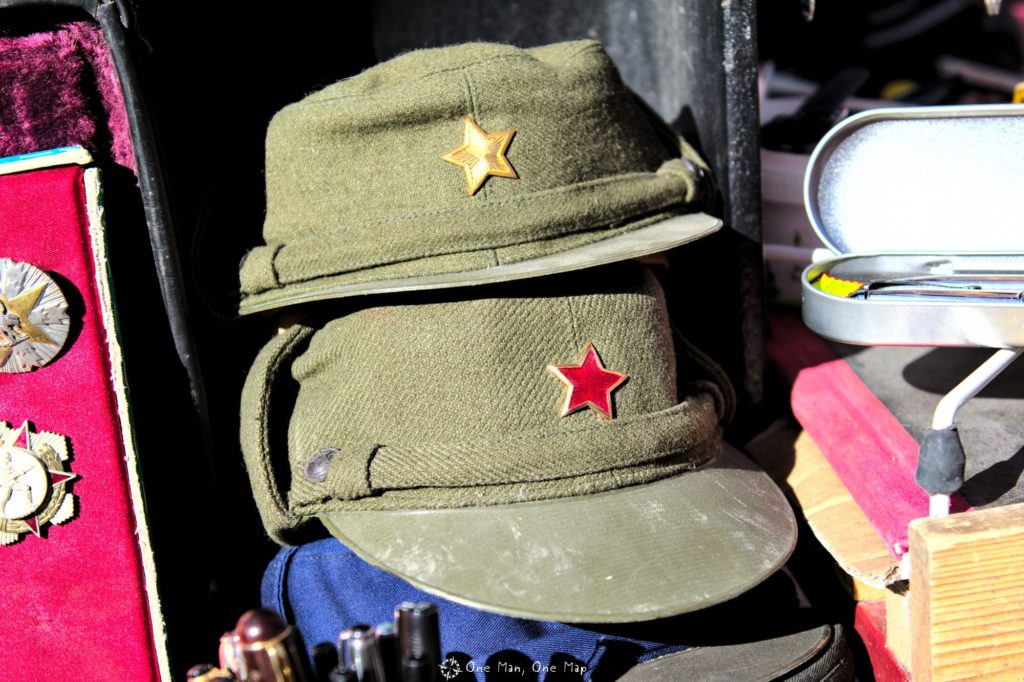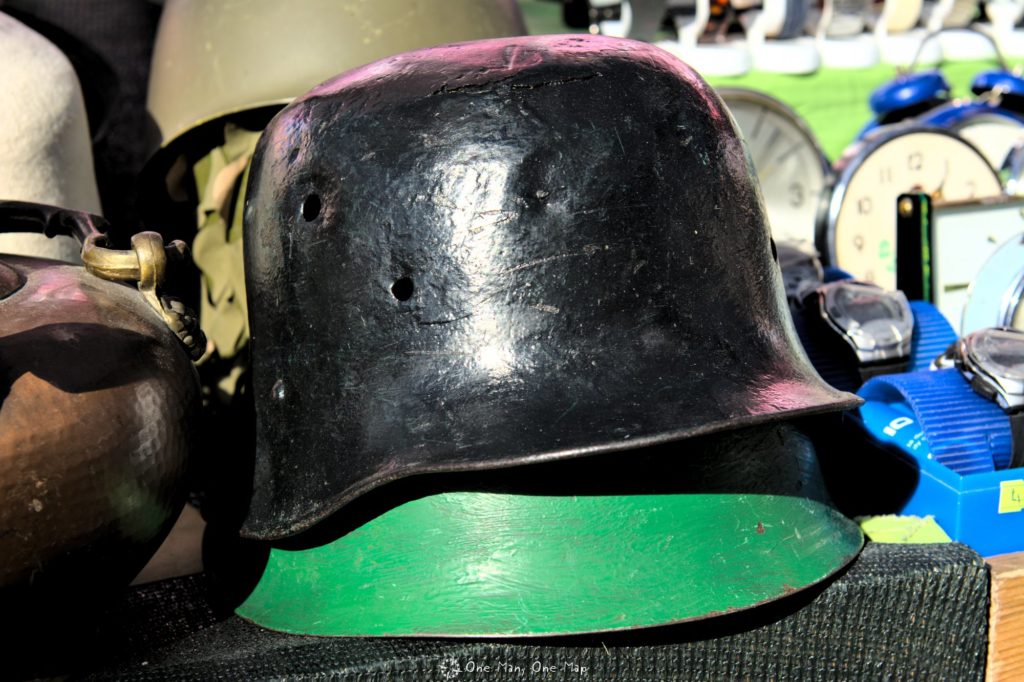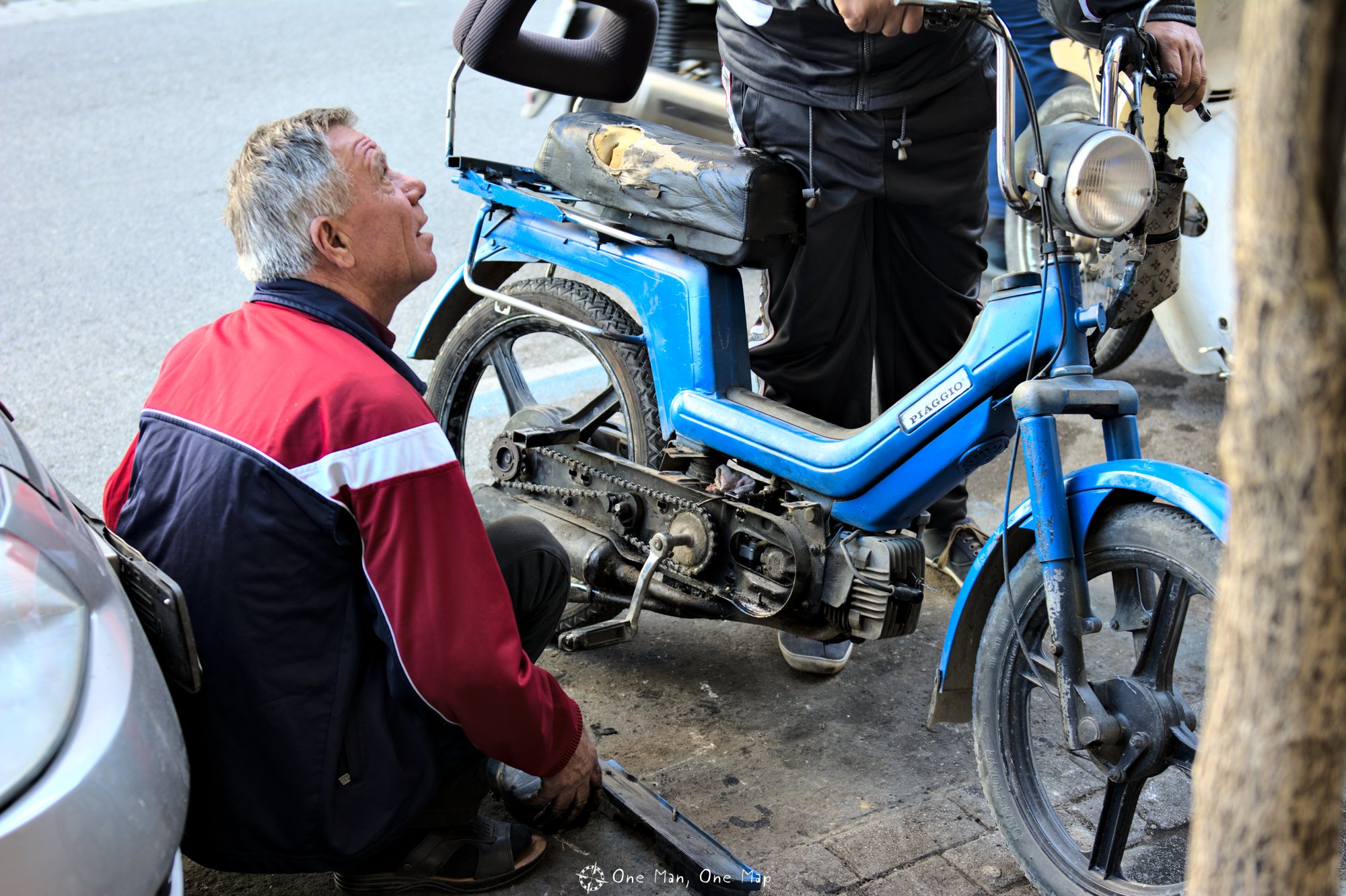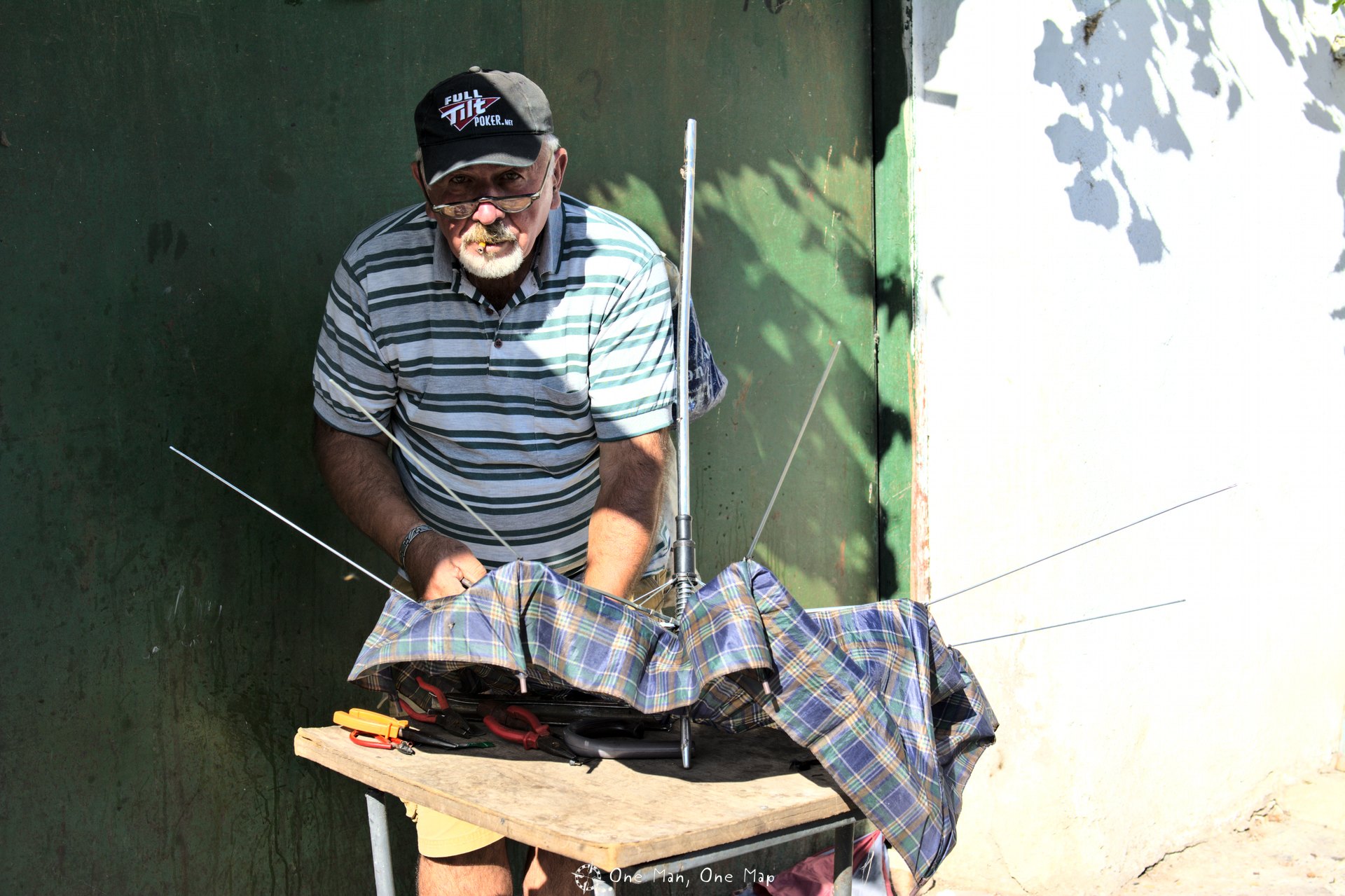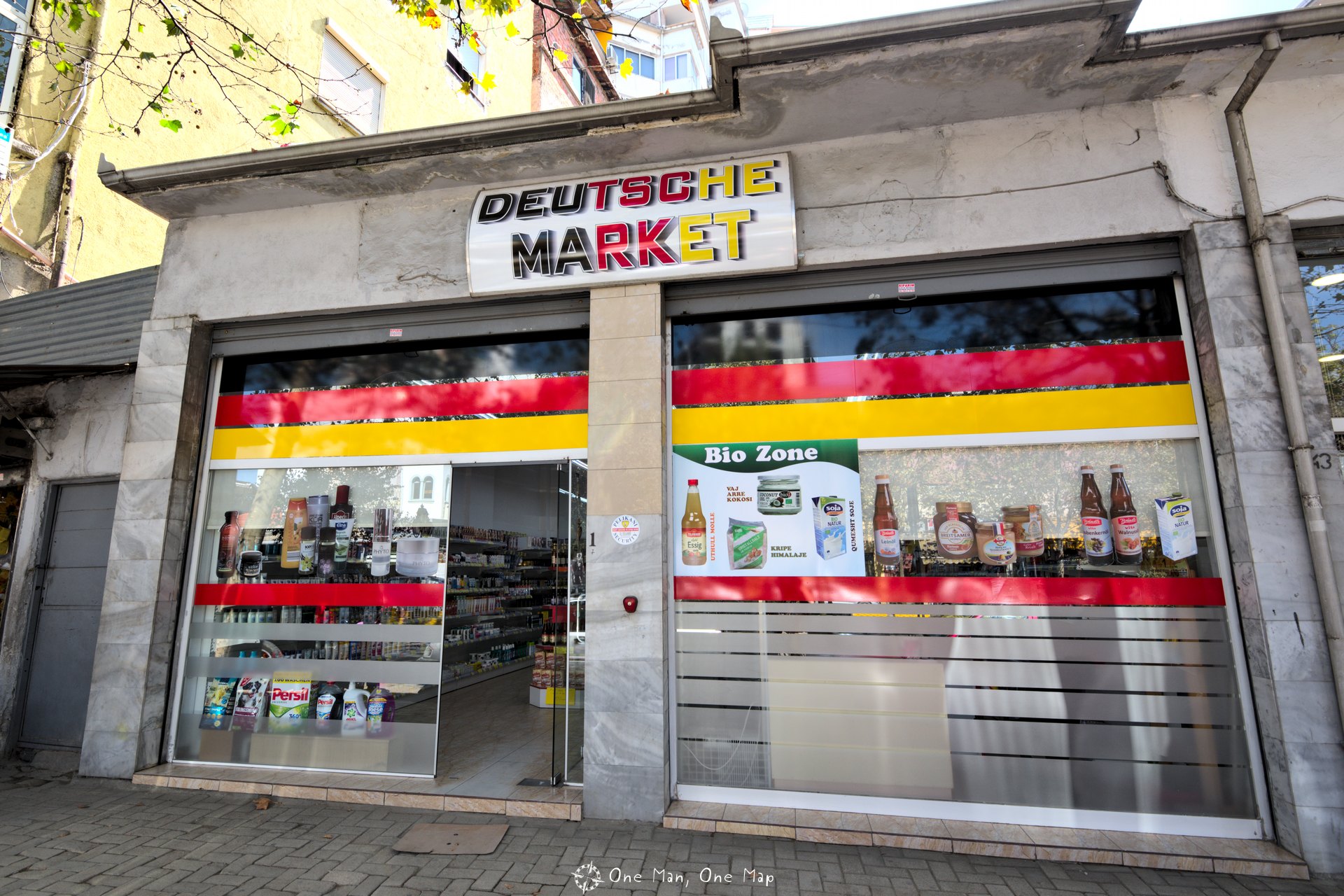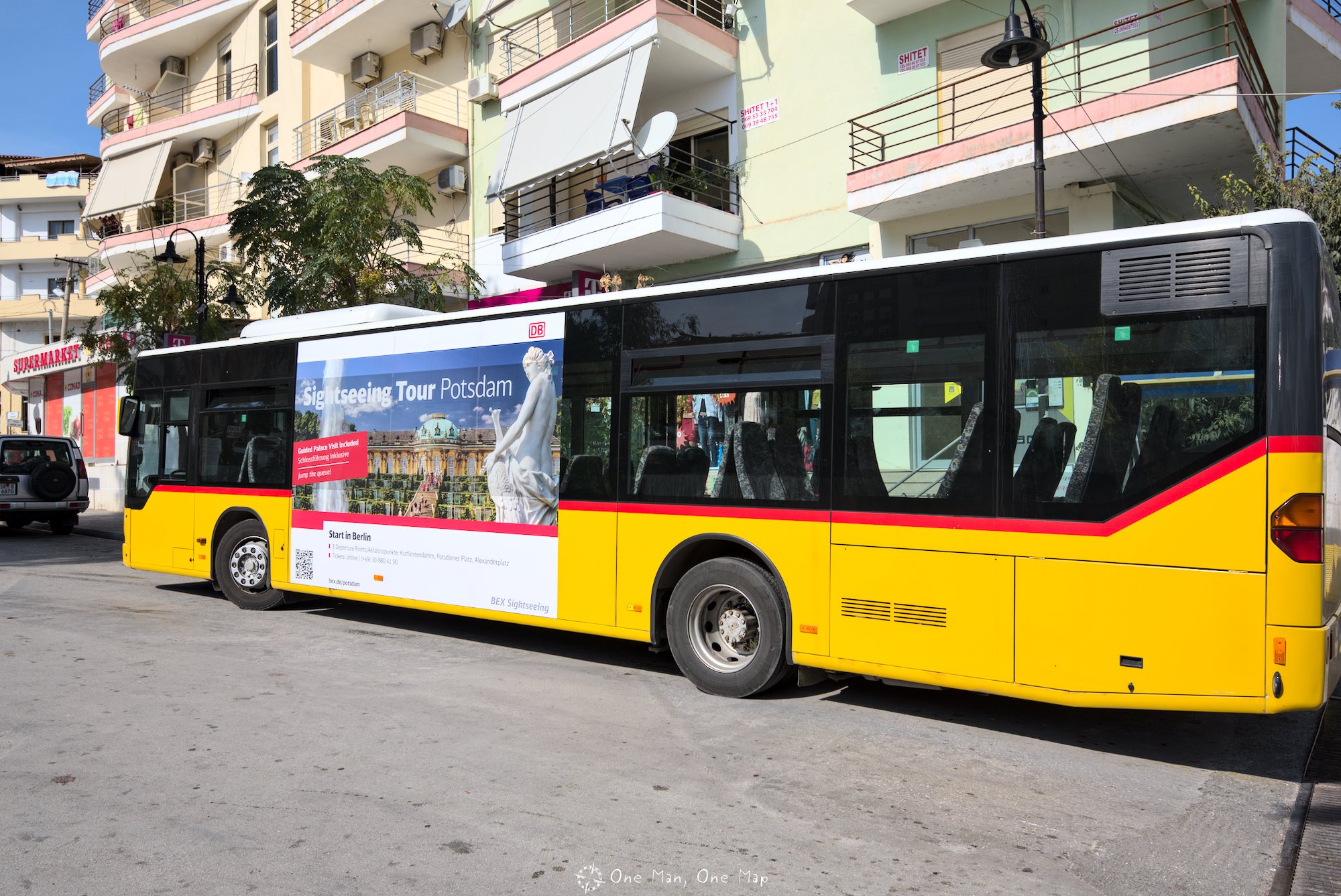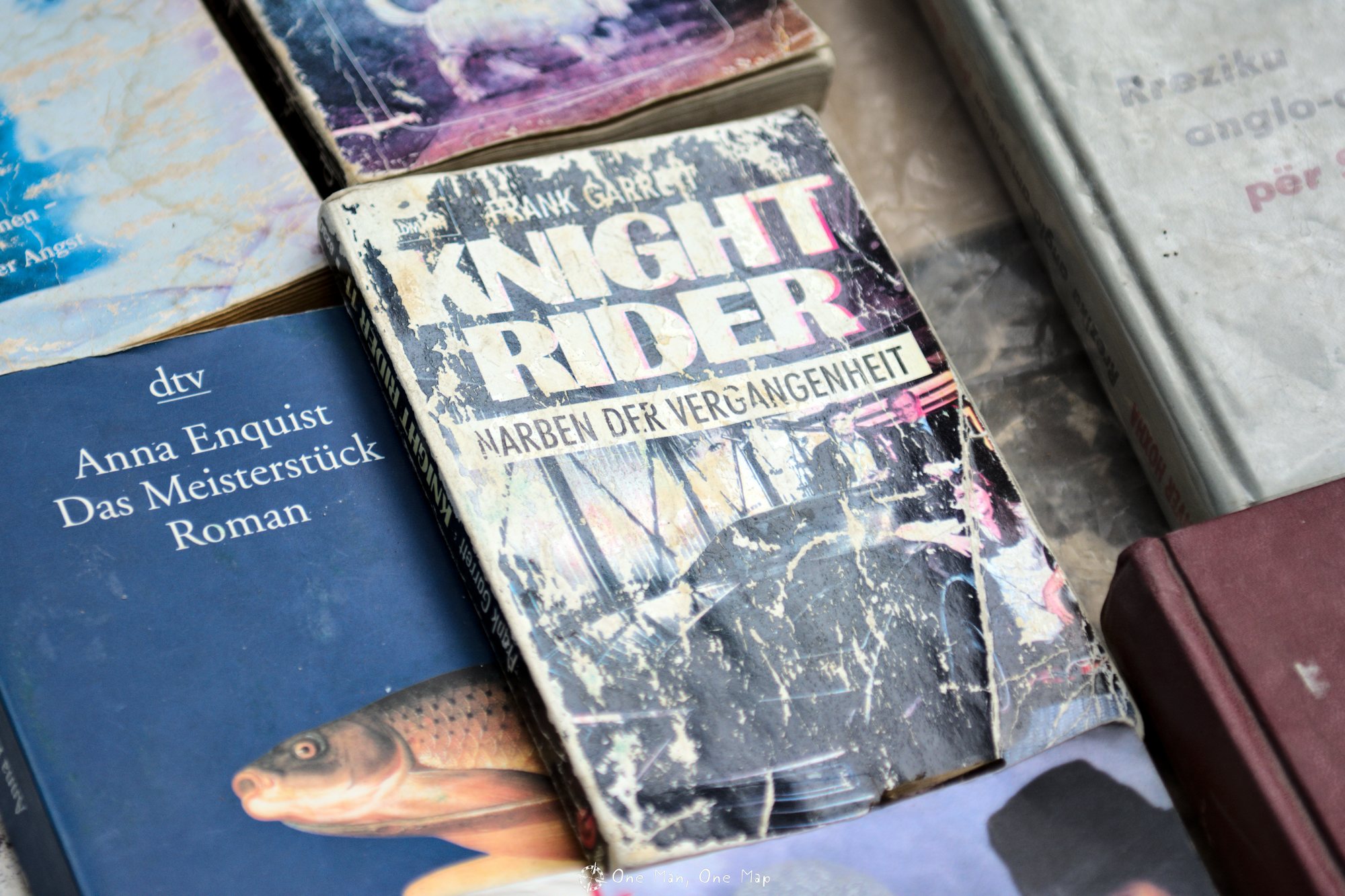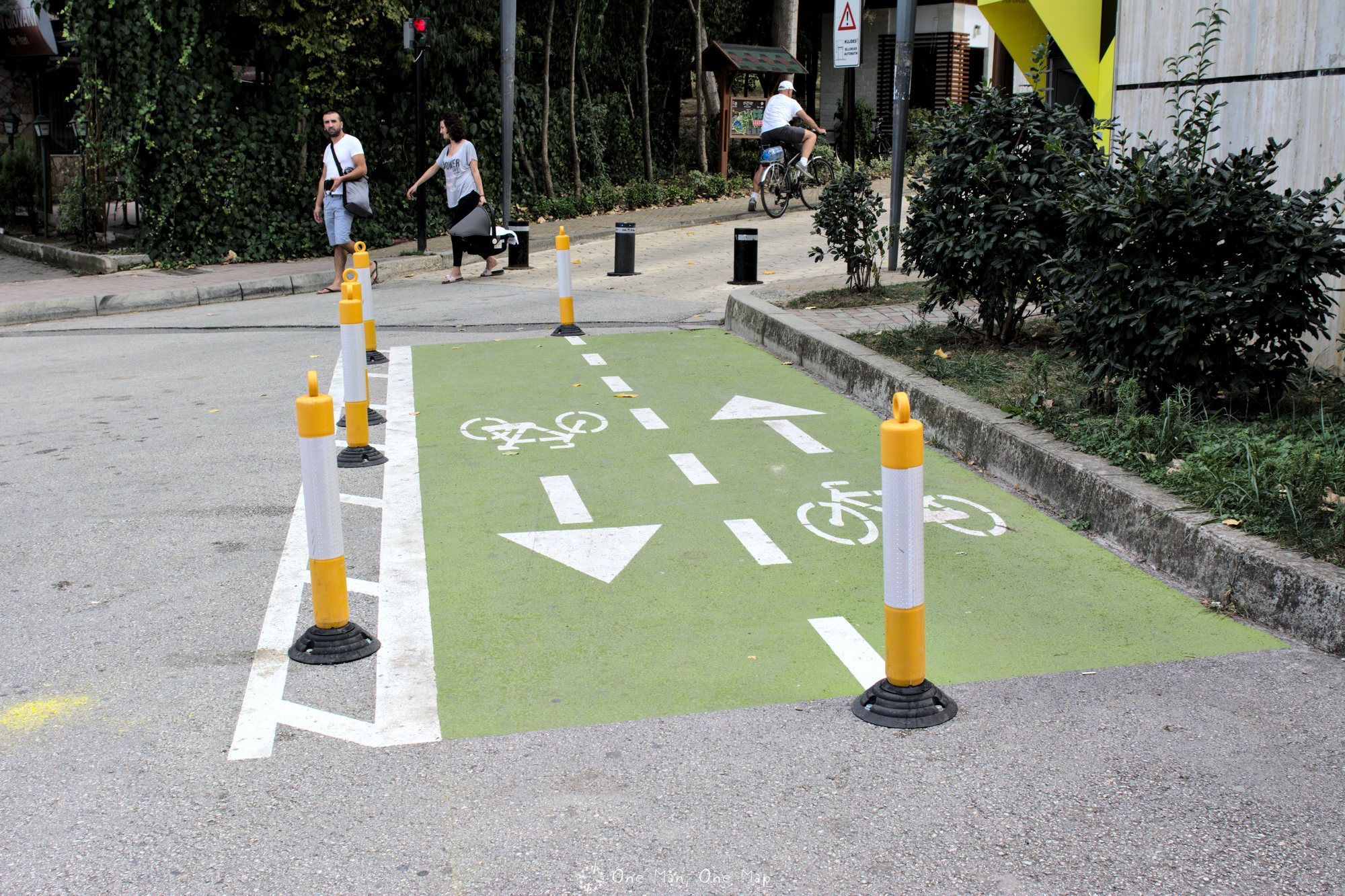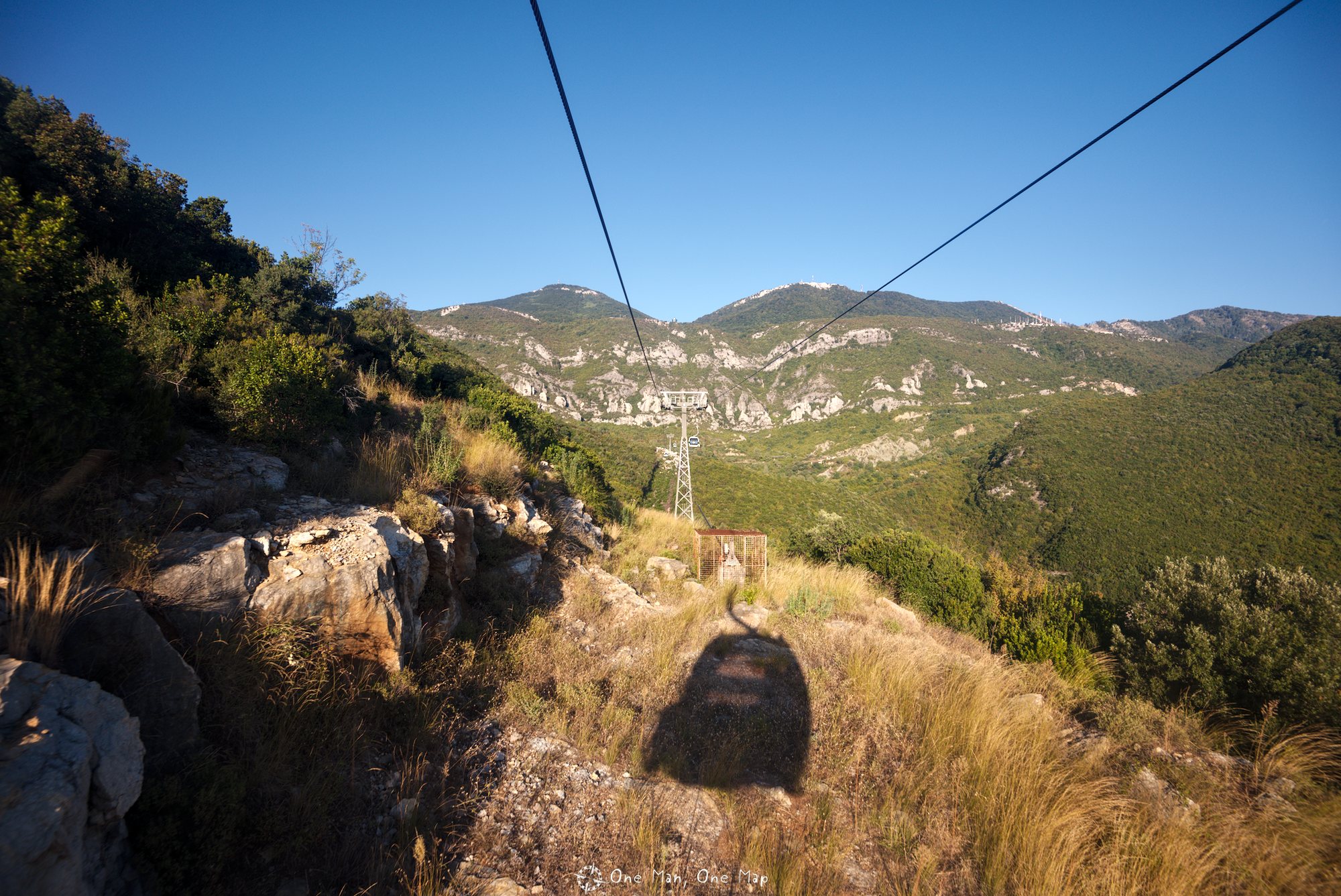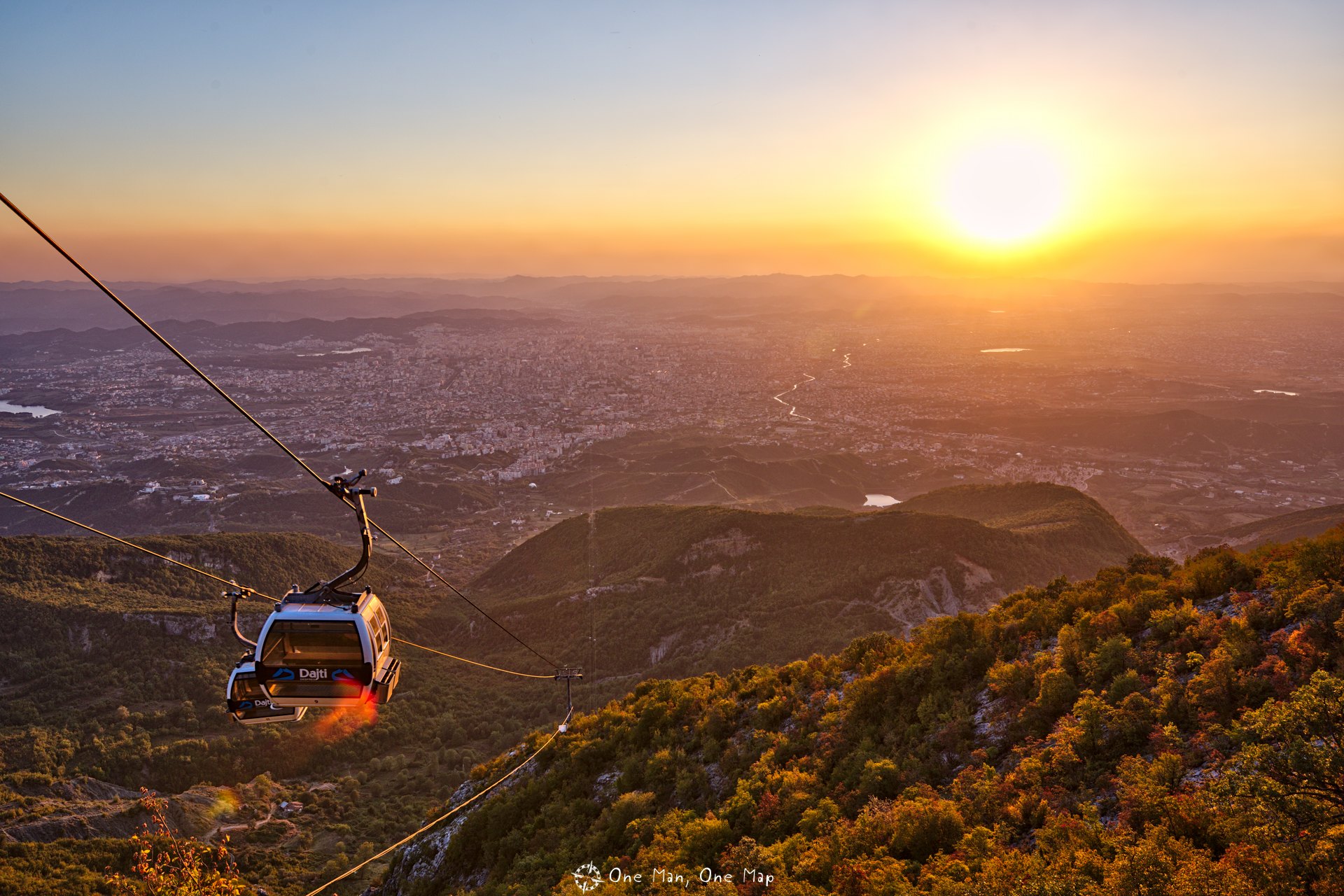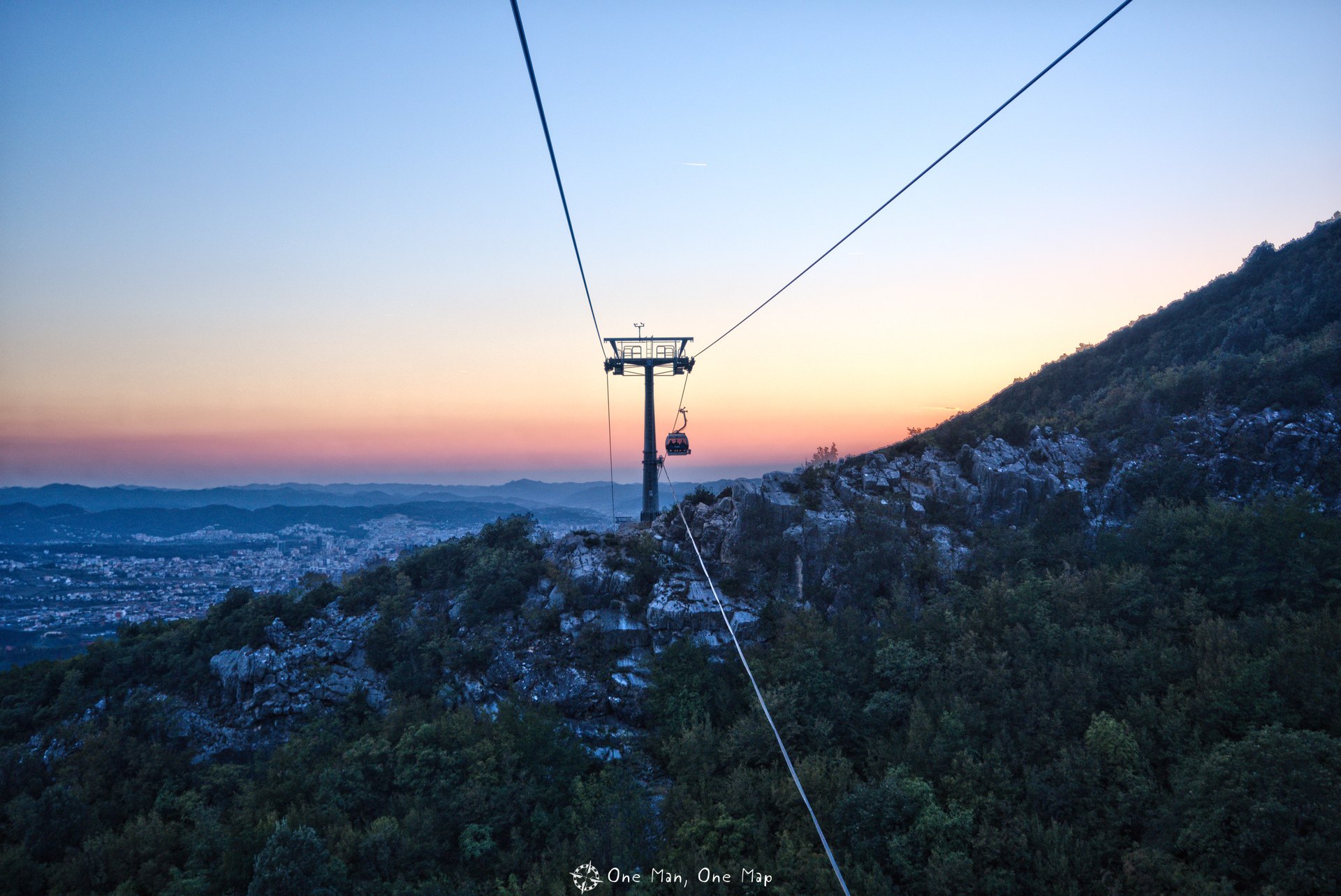Dieser Artikel ist auch auf Deutsch verfügbar. Click here to find out more about Albania!
For an overview on Albania, have a look at the introductory post.
Our first stop in Albania was Tirana, simply because it currently has the only international airport in the country. Until almost 100 years ago, the city was quite small and only had a few thousand inhabitants. Only after it became the capital in 1920 and the Communists under Enver Hoxha took power in 1944, the city grew to about half a million inhabitants.
Most of the cityscape was constructed under the Communist Regime, and it still looks exactly like that. Lots of concrete, large building blocks, a huge central square, badly maintained buildings. There are only few historic buildings. Some were newly built or restored just within the last twenty years.
Nevertheless there’s enough to discover in and around Tirana to keep you busy for at least two days 🙂 Here are a map and a download link with all the GPS data:
Skanderbeg Square (Sheshi Skënderbej)
Named after national hero Georg “Skënderbeu” Kastriota, the central square is located right in the middle of the city. In addition to the Skanderbeg Monument, the National Historical Museum in the former Cultural Palace (Muzeu Historik Kombëtar), the Opera and Ballet Theater (Teatri i Operas the Baletit), the National Library and the National Bank, many other important sights and institutions can be found around this square.

Under dictator Hoxha the square was a bare concrete desert. In recent years the green areas have been restored, playgrounds were added and works of art installed.
From the historic Clock Tower (Kulla e Sahatit) you can get a good view of the square and the surrounding area. The entrance fee was 100 Lek (about 80 Euro-Cents).

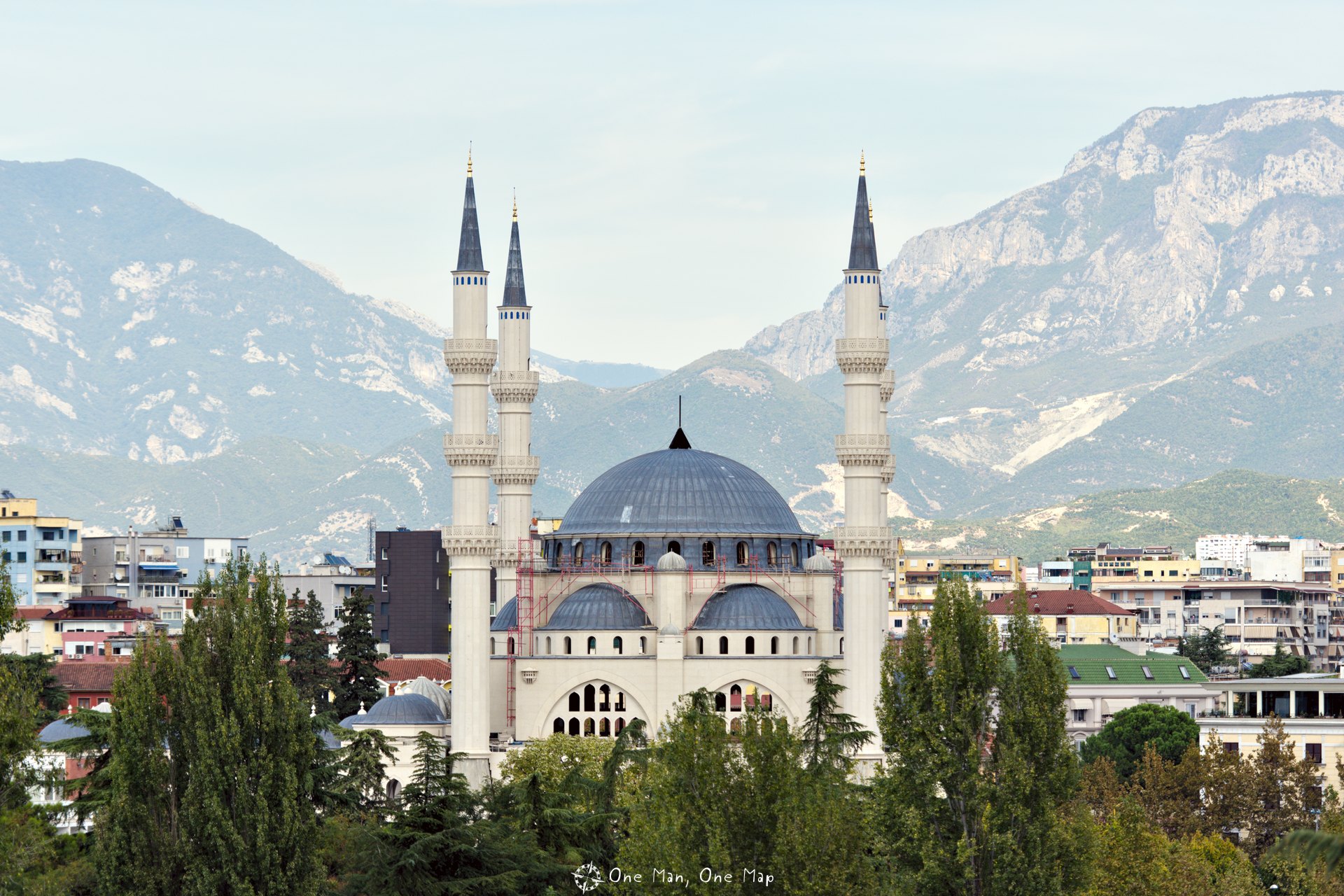
Unfortunately, the whole ugliness of the city also becomes apparent from this lofty height. The concrete blocks from Communist times stretch to the horizon, the outskirts are full of illegal buildings constructed by migrants from rural areas. Some of these buildings still aren’t connected to the electricity grid and don’t even have water taps. But the new, legal buildings in the city center are not necessarily beautiful either…
The best way to see the central place is therefore at night, when you don’t have to see all the chaos 😉
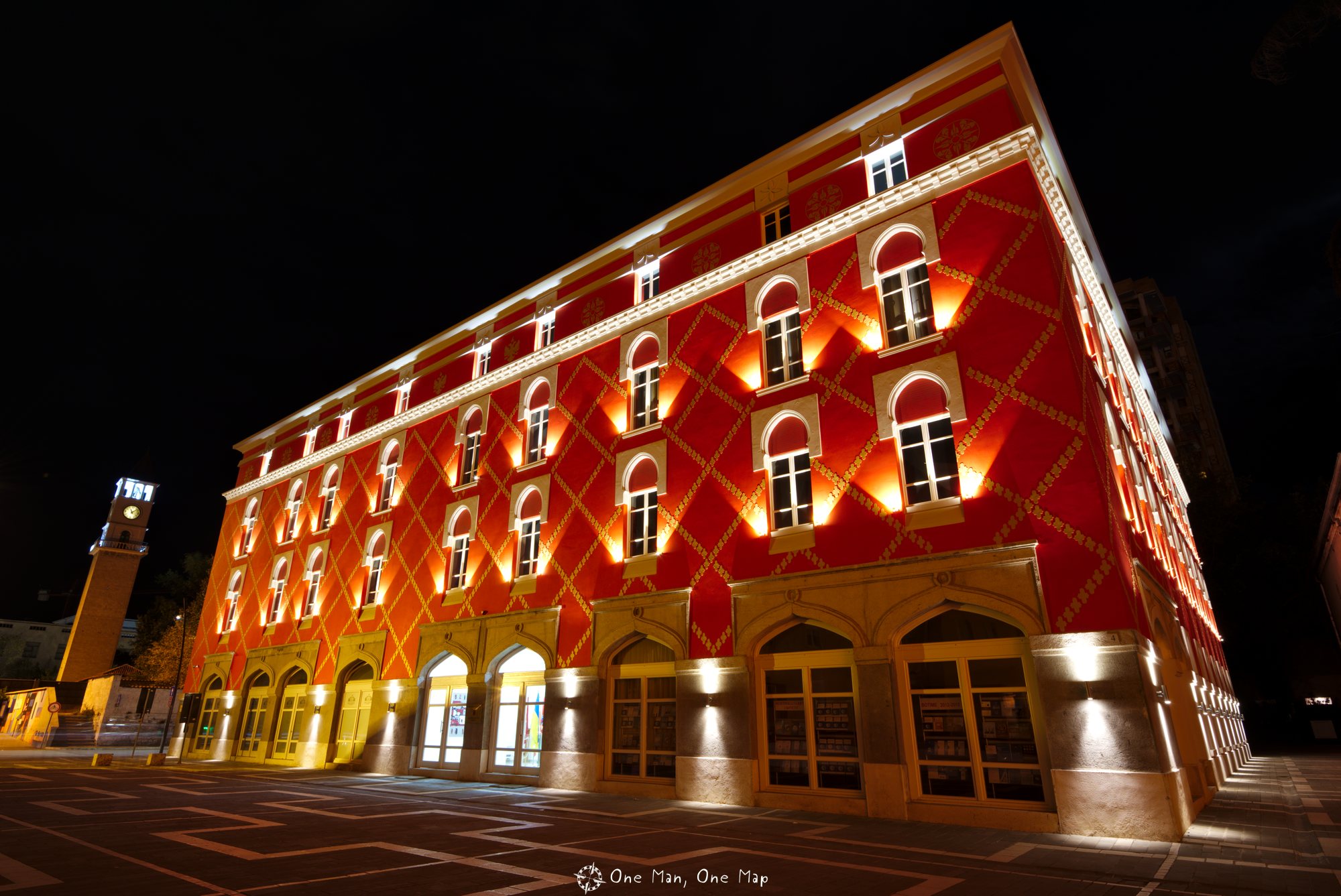
Bunkers, Bunk’Art and the Pyramid
Albania’s dictator Hoxha ruled the country for 40 years. In the late 1960s he became increasingly paranoid and fortified the country against a supposed attack by foreign powers. The most important part of his plans was the planned construction of 750,000 military bunkers. Tirana was especially fortified. Thousands of bunkers were constructed all over the cityscape, aligned on 50 concentric circles. Most are still in place for lack of money to remove them. They can be found along the streets and in the parks of the capital, many are easily accessible.
There were also several nuclear bunkers for the communist leadership. One of them is located right next to Skanderbeg Square and has been converted into a museum called Bunk’Art 2. In the professionally designed underground rooms one can learn more about the persecution of the opposition by Communist Secret Police Sigurimi. The entrance fee was 500 Lek (about 4 Euros). About one to two hours should be planned for the visit.
A second bunker museum called Bunk’Art 1 is located further out near Linza. It is much bigger and occupies the insides of a whole mountain. The best way to visit it is in combination with the cable car ride to Mount Dajti. The base station of the cable car Dajti Express is located right next to the entrance of Bunk’Art 1. The entrance fee was 500 Lek.
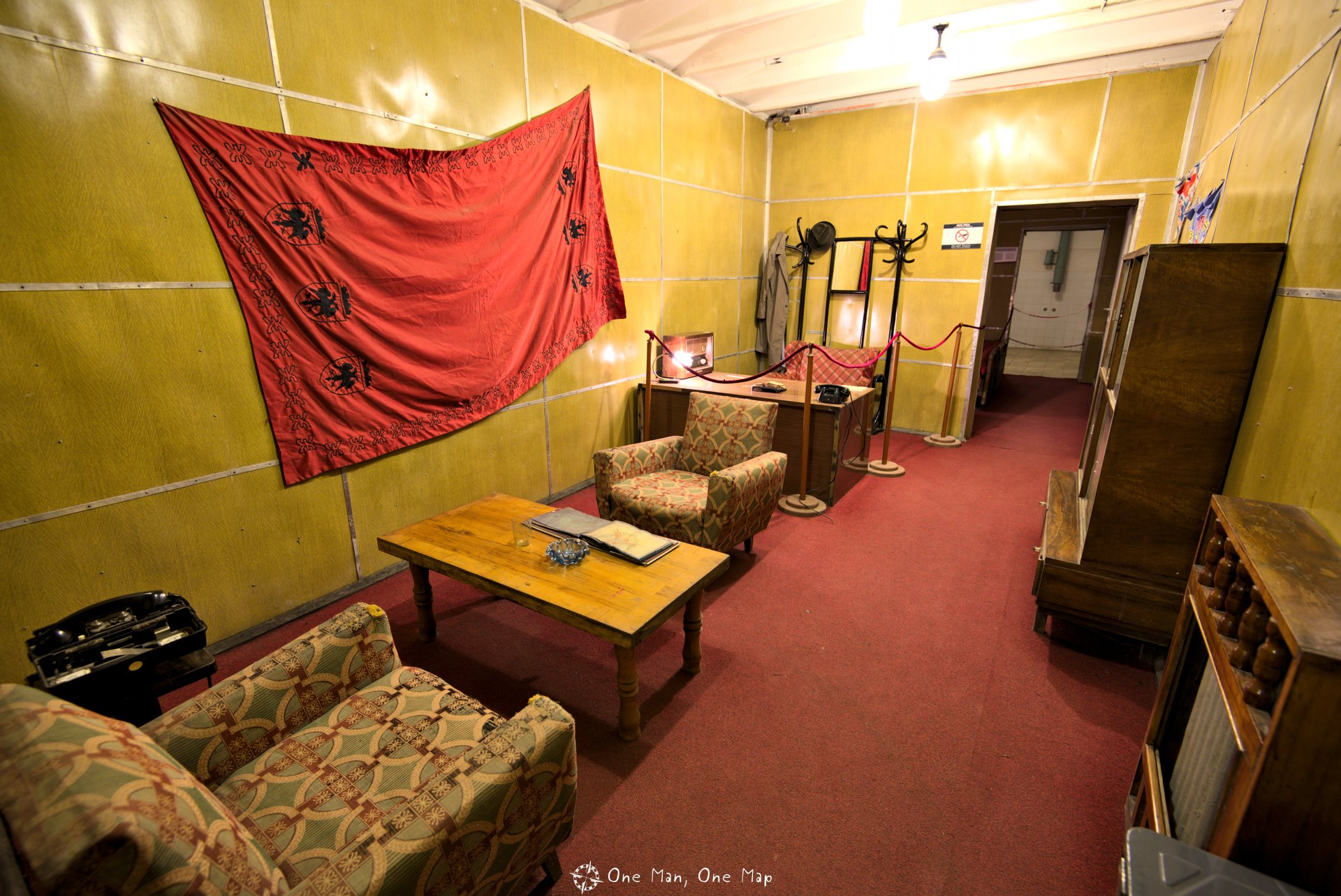
Another bunker-like structure is the hard to miss former Enver Hoxha Museum, usually referred to as the “Pyramid of Tirana” (Piramida). The dictators’ daughter, architect Pranvera Hoxha, planned the building after her father’s death. The construction took two years. According to the legend it was the most expensive building ever built in Albania.
Until 1991 “more or less everything Enver Hoxha had ever touched” was located here. In the center of the pyramid there was a marble statue of the ex-dictator. A large stage with an auditorium hosted high-ranking celebrations. After the opening of the country, the pyramid was converted into an International Cultural Center (Qendra Ndërkombëtare e Kulturës). Later it housed offices, bars and a discotheque. Then came bankruptcy and decay. Again and again proposals for further use were made, most recently in 2018 the conversion into a Technology Park for Startups. But nothing has happened so far.
In front of the pyramid is the peace bell built in 2000 (Këmbana e Paqes). It is a reminder for the riots leading to the Albanian Civil War in 1997, which had to be pacified by United Nations Peacekeepers. The bell itself was cast from bullet shells collected in Albania.
Museum “House of Leaves” (Shtëpia e Gjetheve)
The “House of Leaves” is an inconspicuous, overgrown building near Skanderbeg Square. For decades the headquarters of the Communist Secret Police Sigurimi was located here. Hundreds of thousands of people were spied on by the regime, tens of thousands were imprisoned and killed in secret prisons. A whole department was responsible for the censorship of the media. About 20 percent of the population are assumed to have cooperated with the secret police in various ways.
The well-made exhibition houses a large collection of surveillance equipment, sound recordings, movies and original documents. Although most documents are only available in Albanian language, I highly recommend a visit. The rather absurd propaganda movies and the many surveillance devices from abroad, including extremely expensive cameras from Japan and hundreds of tape recorders from West Germany, were our personal highlights.
The entrance fee was 700 Lek (about 5.60 Euros). Photography is prohibited inside of the museum, but not in the air raid shelter in the garden.
Resurrection Cathedral (Ringjallja e Krishtit)
Enver Hoxha officially banned all religions in 1967 and declared Albania to be the “first atheistic country in the world”. Nevertheless atheists make up less than ten percent of the Albanian society nowadays. Most people are Muslims, about 15 percent are Christians of different movements. The largest share of them is Catholic and lives in the North on the border with Montenegro.
Between Tirana and Gjirokastër, however, lies the sphere of influence of a very own national Christian movement, the Autocephalous Orthodox Church of Albania. In 2010 it inaugurated a new Resurrection Church opposite the House of Leaves. It is quite interesting due to its unique architectural features. The interior is round and topped by a dome almost 30 meters in diameter, the bell tower consists of four Easter candles.
Urban Art
The city administration of Tirana tries to keep the city center attractive. The best example for this is probably the art installation “The Serpentine Pavilion” by Japanese architect Sou Fujimoto in front of the National Art Gallery (Galeria Kombëtare e Arteve), on loan from London. The structure looks quite beautiful, especially at night.
But you can also discover a lot of street art throughout the city. A special feature are the painted electrical power distributors – every single unit has its own design.
Mother Teresa
Probably everybody knows Saint Teresa of Calcutta, but not everyone might know that Agnes Gonxha Bojaxhiu was of Albanian descent. Today she is pretty much the national saint next to national hero Skanderbeg. Everything from the International Airport to the Central Hospital in Tirana is named after “Nënë Tereza” (Mother Teresa). There are also lots statues of her everywhere in Albania, Kosovo and northern Macedonia, sometimes even in the middle of roundabouts.
The statue in the picture was erected in front of St. Paul’s Cathedral in Tirana for her 100th birthday.
New Bazaar (Pazari i Ri)
The old Ottoman Bazaar had to give way to a normal market in 1931, and in 2017 the old wooden roofs were replaced by a construction made of glass and steel. Since then, this district east of Skanderbeg Square has become a popular leisure and entertainment district with probably more bars and restaurants than market stalls.
In addition to fruits, vegetables and delicacies there were also lots of antiques from the Communist era on sale. These were most likely actually genuine originals and not copies, but unfortunately there was no more free space in my luggage for yet another analog camera…
Craftsmen offered their services in the quarter around the market. Some had worked their way up to small shops and workshops, others just worked on the street.
The peculiar
The Albanians like Germany. They really like Germany. This “German Market” for example is a shop which exclusively sells (discount store) products imported from Germany, at a steep surcharge. Or look at the old city bus from Berlin, including the original Deutsche Bahn advertising…
Okay, this bike path may not be long, but at least there is one. And it is very well secured. It’s the thought that counts. The city administration definitely can’t be accused of a lack of will!
Mount Dajti and Dajti Ekspres
The Dajti is the local mountain of Tirana and a national park at the same time. Since June 2005, an almost five kilometers long gondola lift has been transporting tourists and hikers from the eastern outskirts of the city to the 1050 meter high Plain of Dajti (Fusha e Dajtit). The 1613 meter high mountain peak is unfortunately a restricted military area, otherwise the cable car would probably continue to the very top.
From the plain one would have a wonderful panoramic view of Tirana, if the city center wasn’t nine kilometers away and hidden in all the smog. The whole experience is also a comparatively expensive. The return trip on the gondola cost 1000 Lek (about 8 Euros), the prices at the restaurant and the bar at the top station were high, and access to the good viewing points (tower, terrace, rotating bar) was restricted to paying guests of the hotel or restaurant. At least we could look down on the city for free from a small garden on the northern side.
The valley station is best reached using bus line 1 (Quender-Porcelain) or bus line 2 (Kombinat-Quender-Kinostudio). We hopped on line 1 at the Clock Tower stop (Kulla e Sahatit). You can ride the bus to the station Teleferiku and walk from there, or use the provided Dajti Ekspres shuttle bus. We got off at Market Hippo Station, visited Bunk’Art 1 and then walked up to the valley station of the Dajti Ekspres.
But that was not all from our first stop in Albania. Of course we couldn’t just let the Dictator’s Pyramid stand there in peace and not take a look inside.. 😉
This post was written by Simon for One Man, One Map. The original can be found here. All rights reserved.

